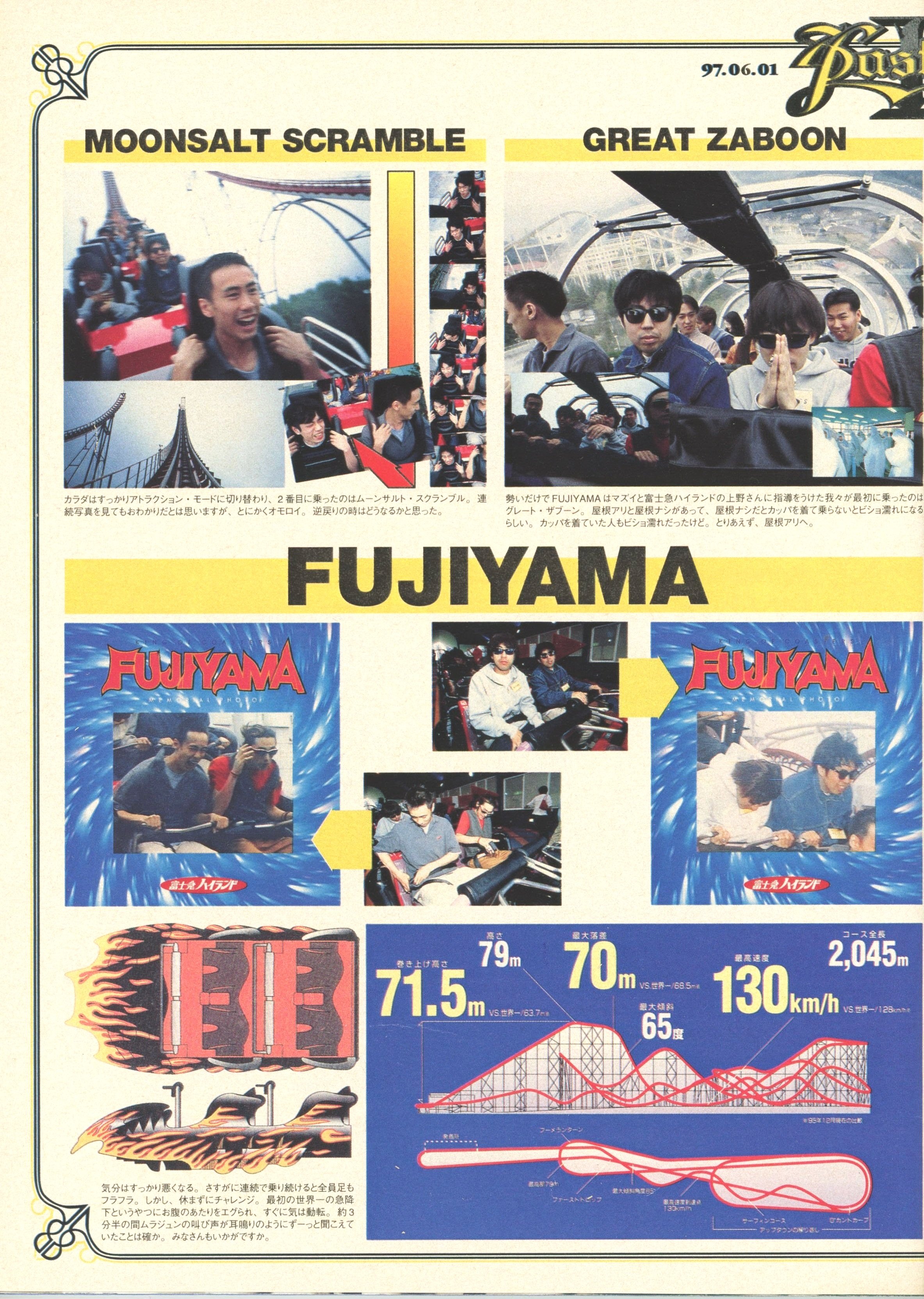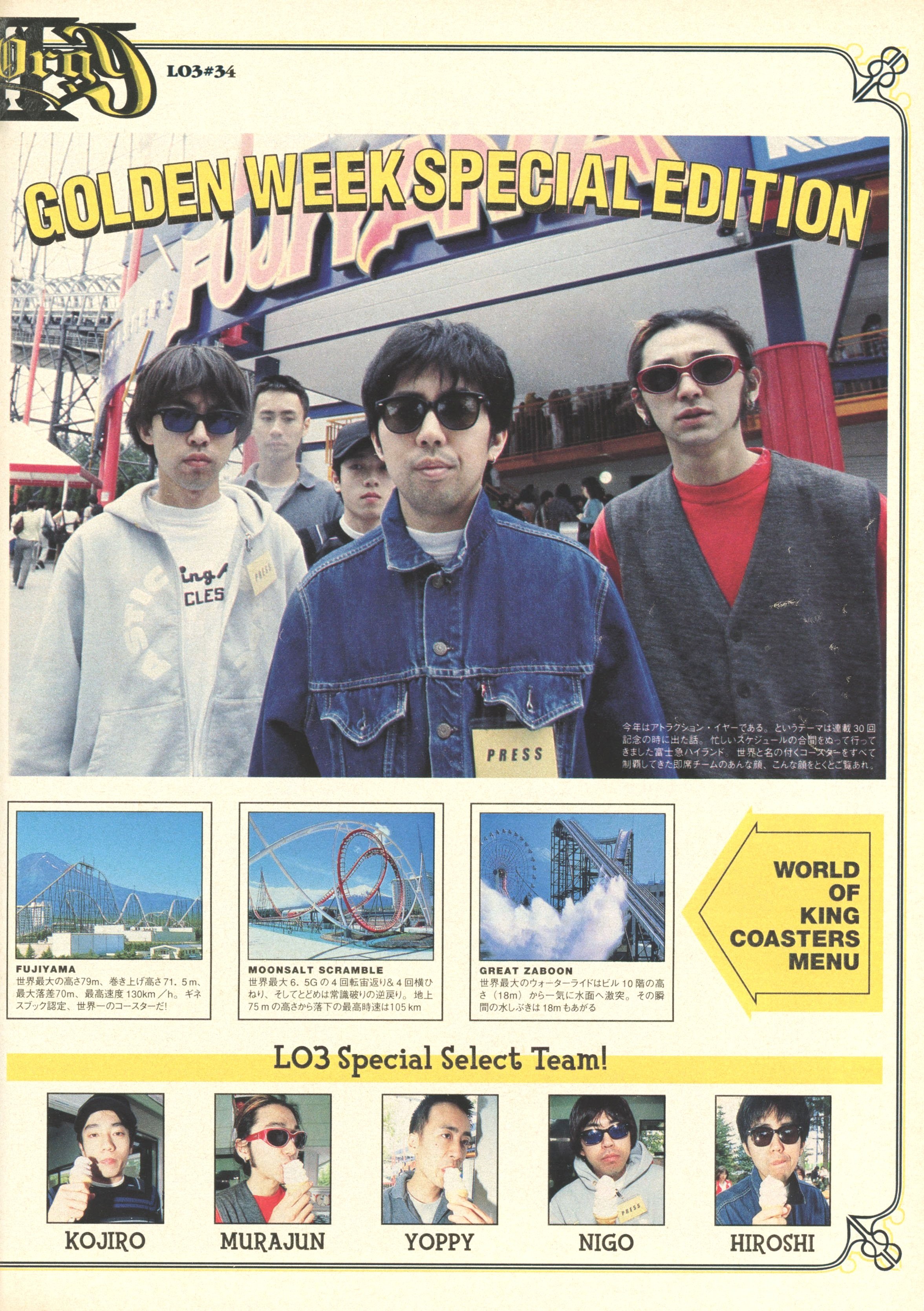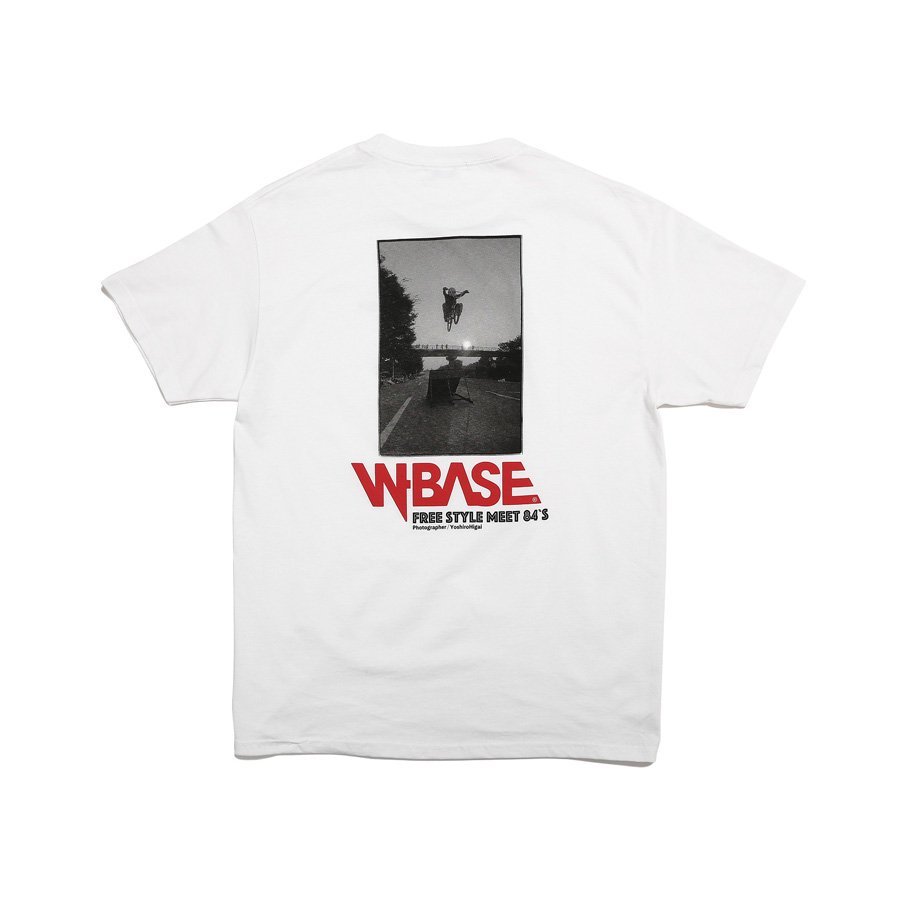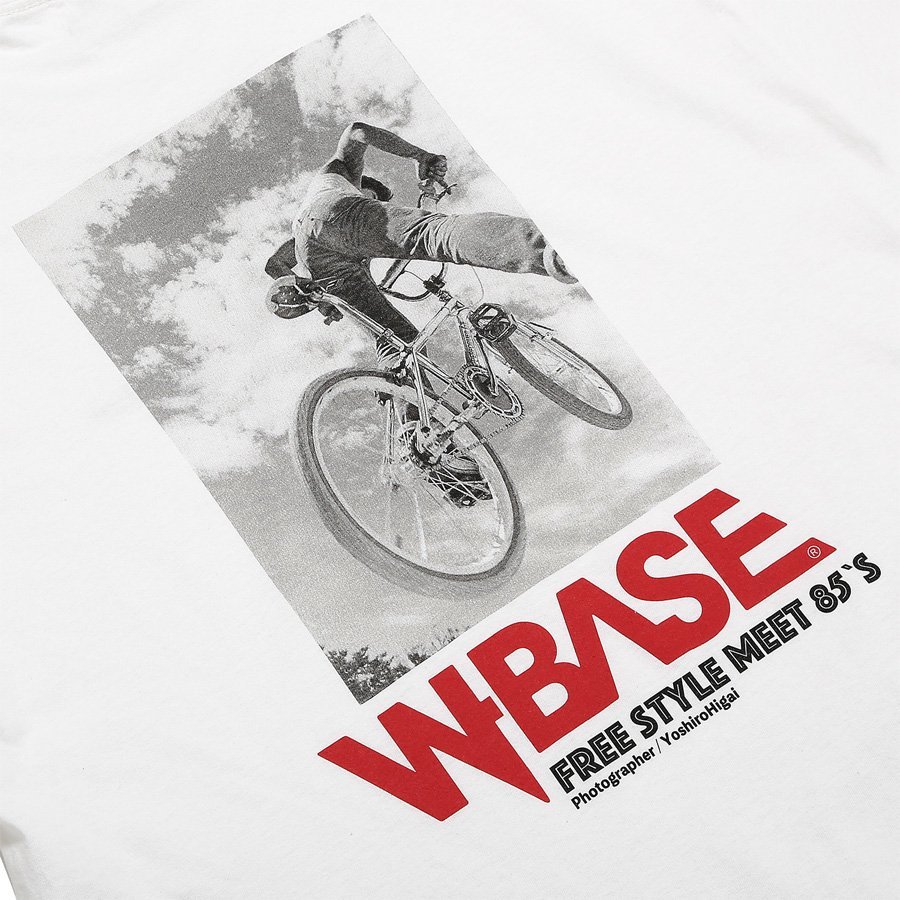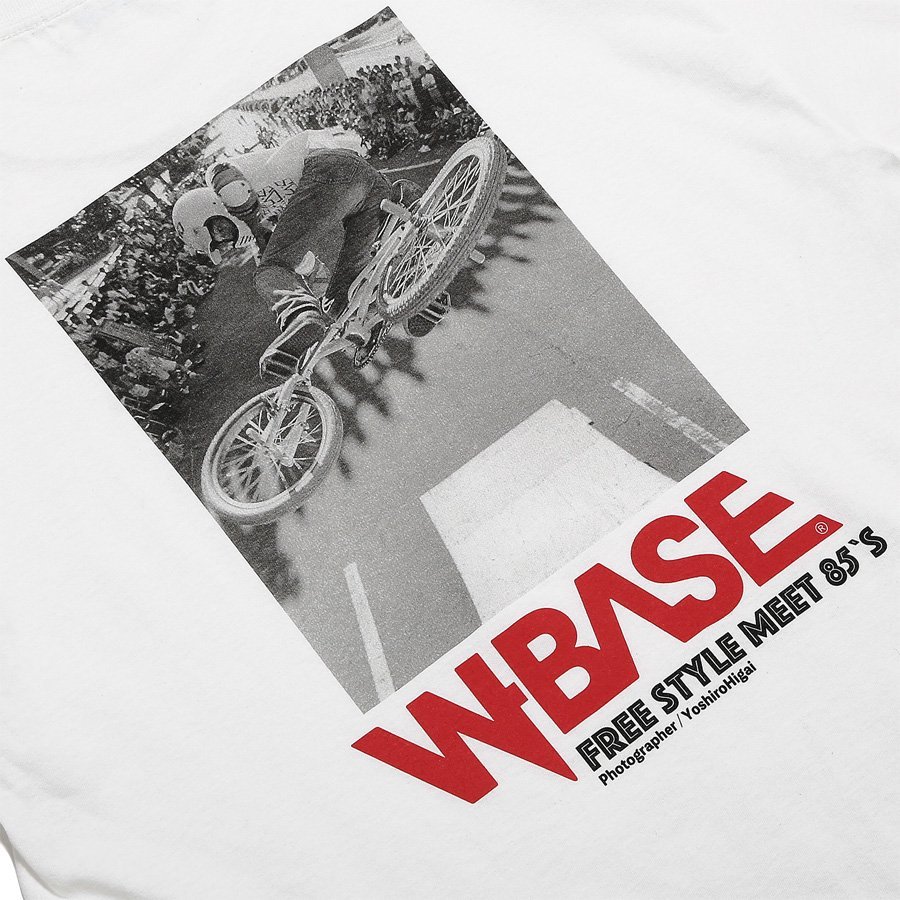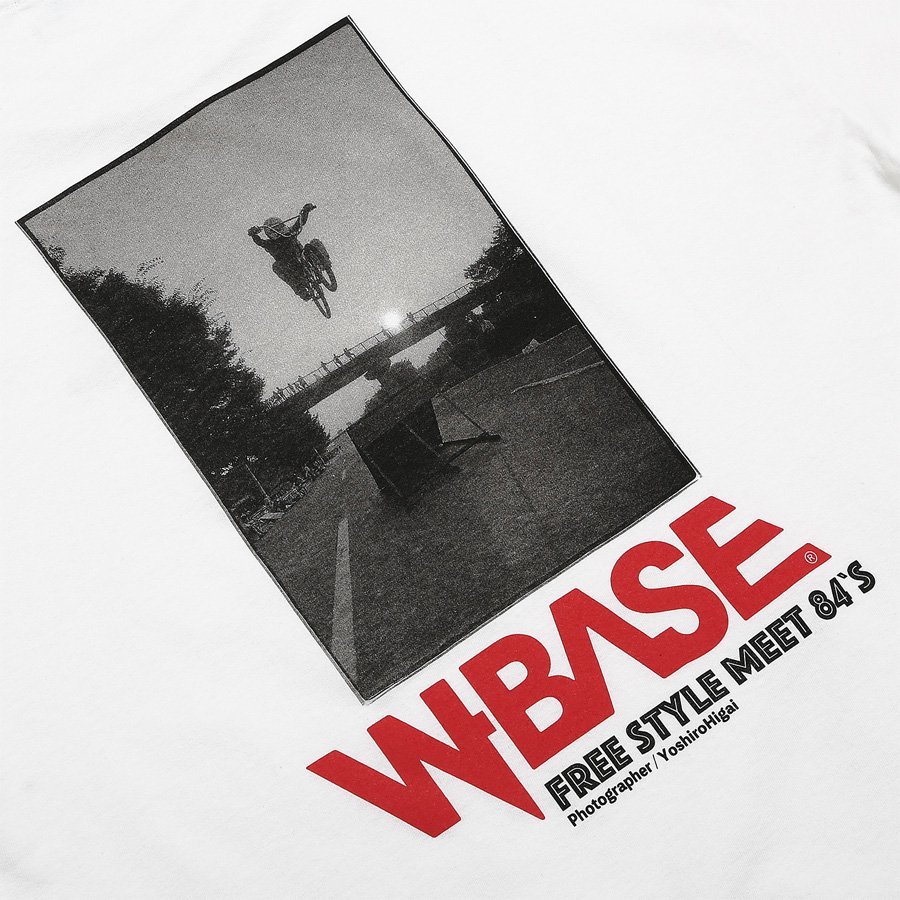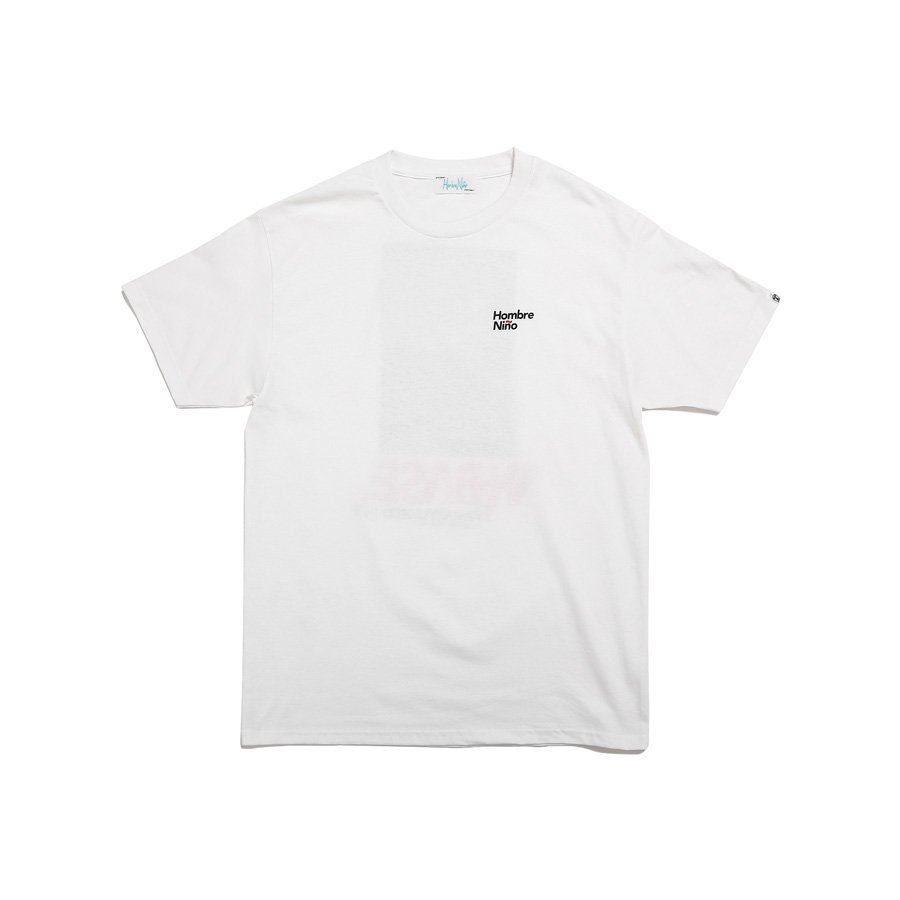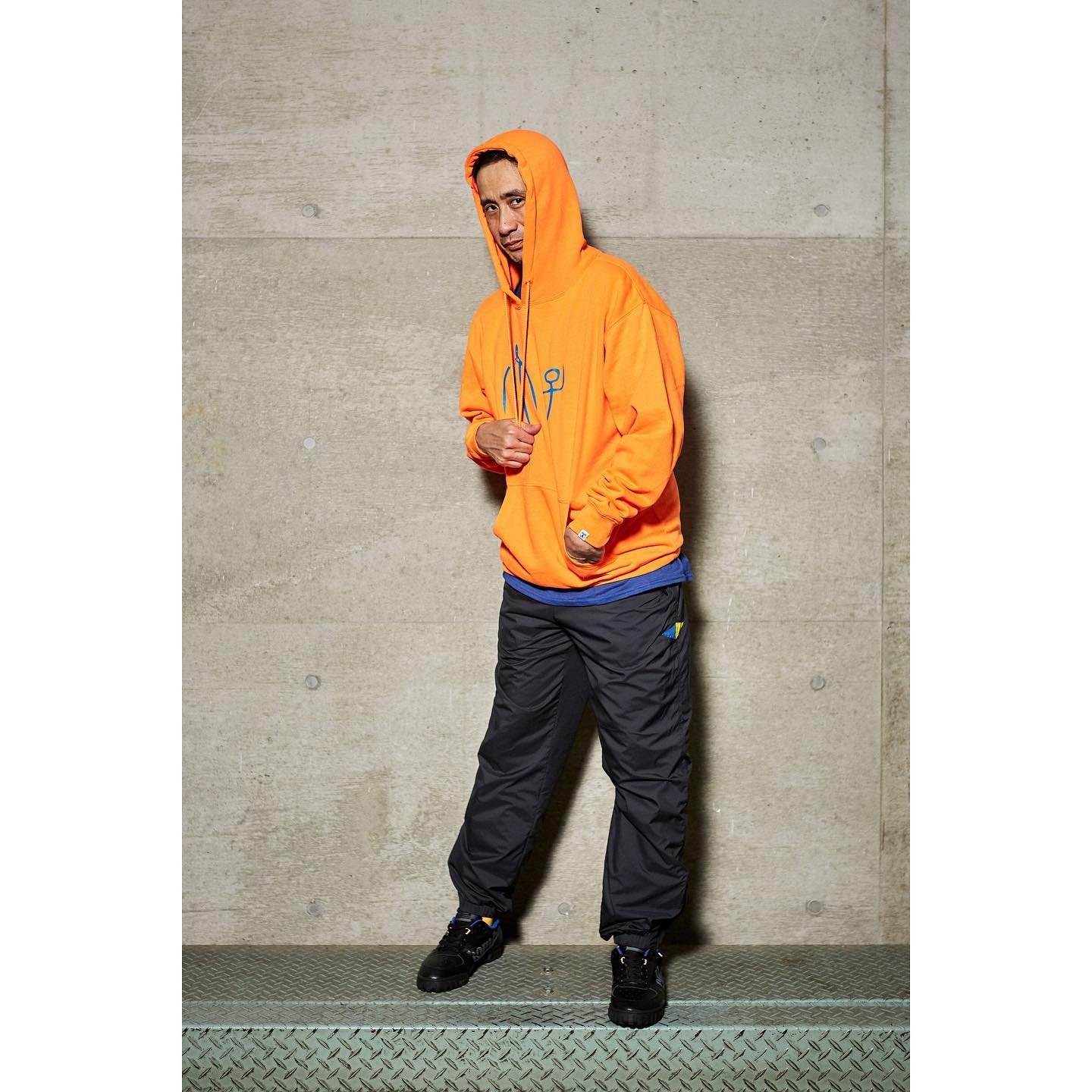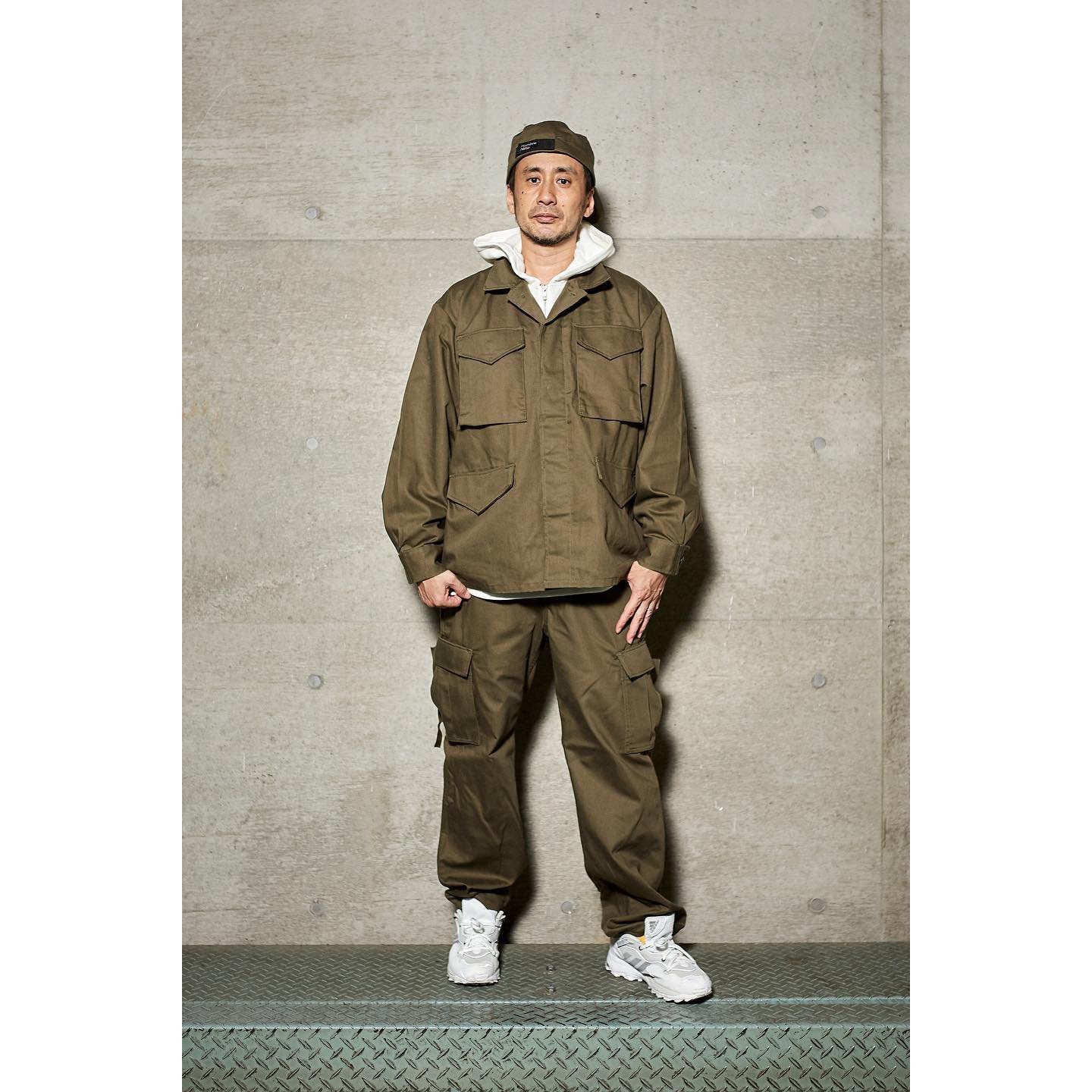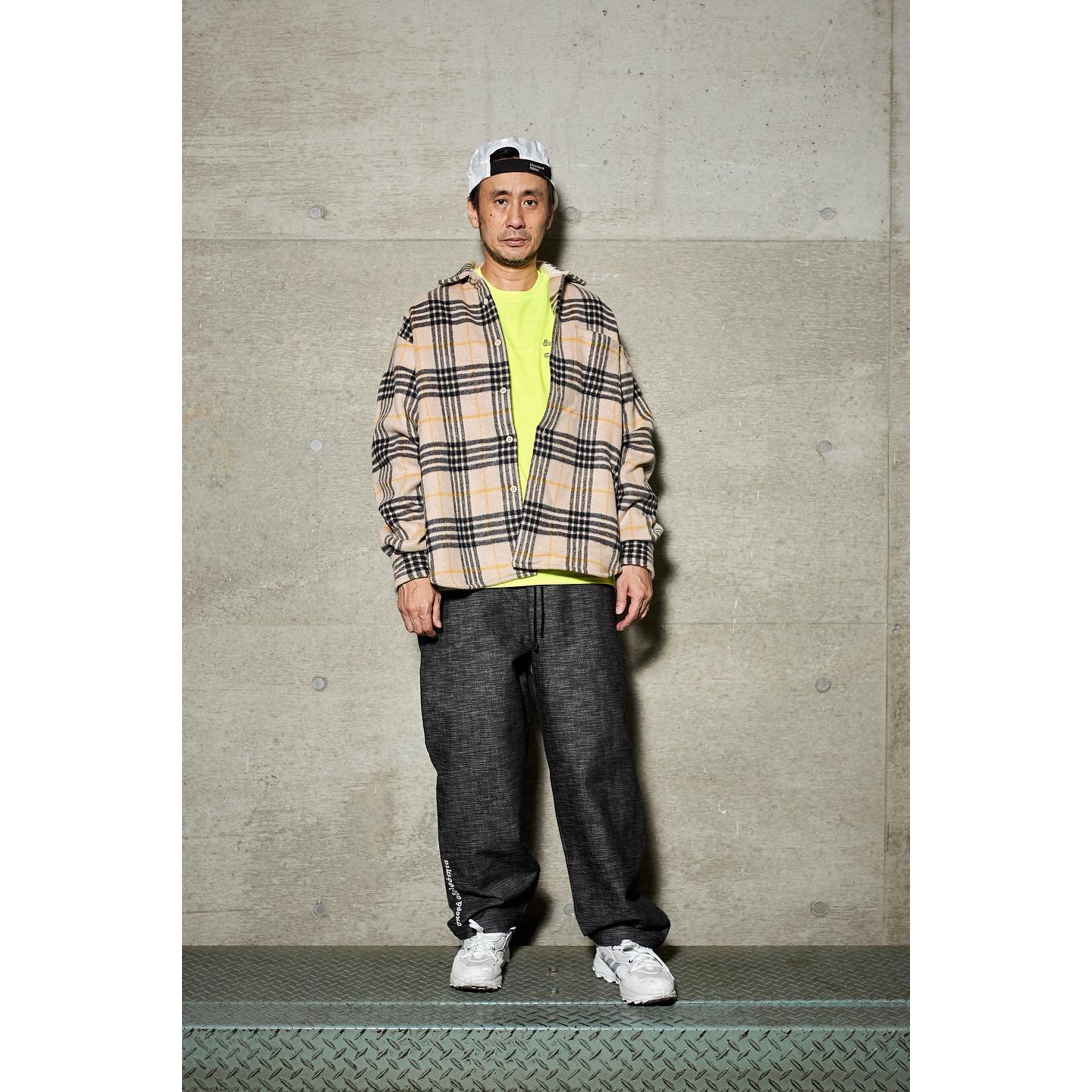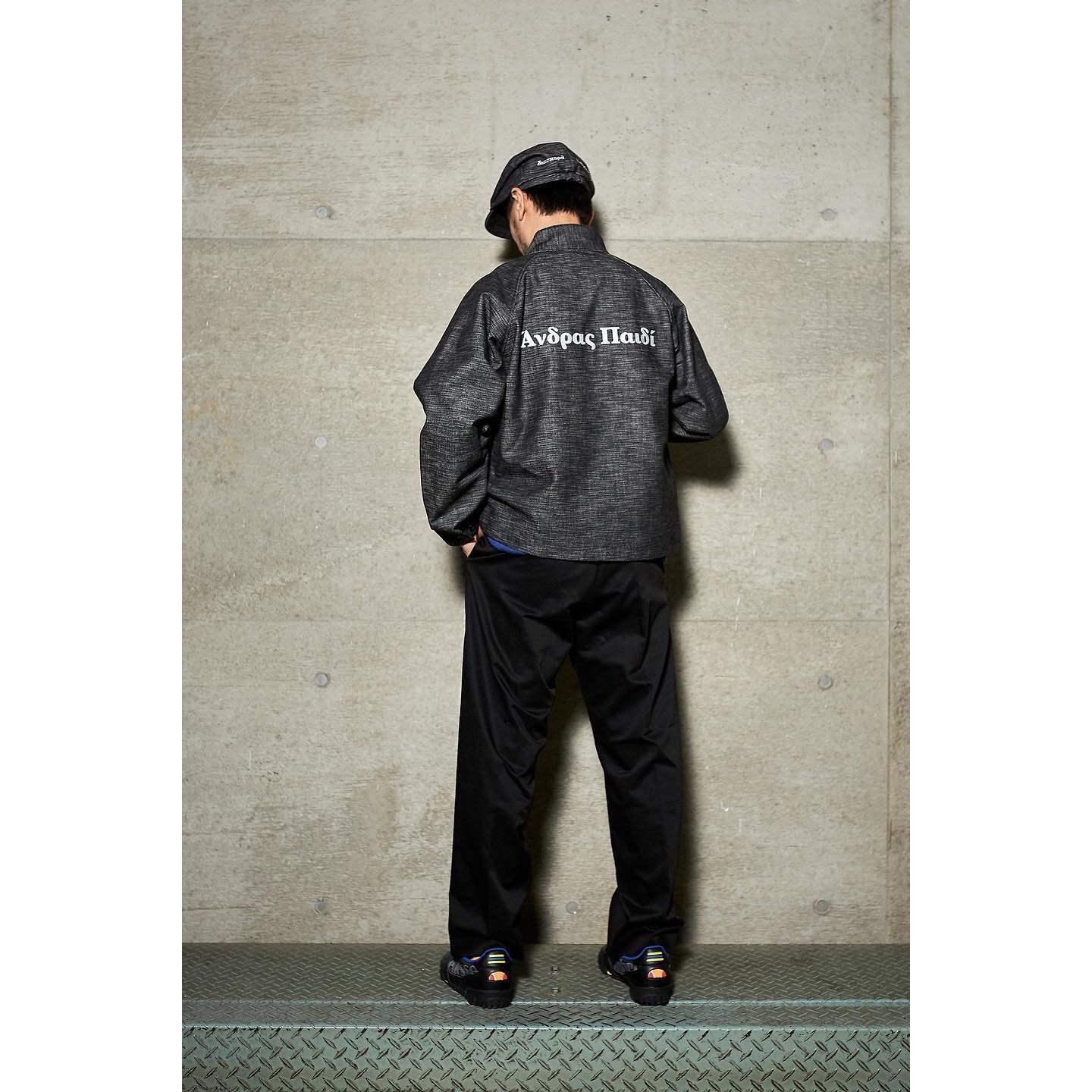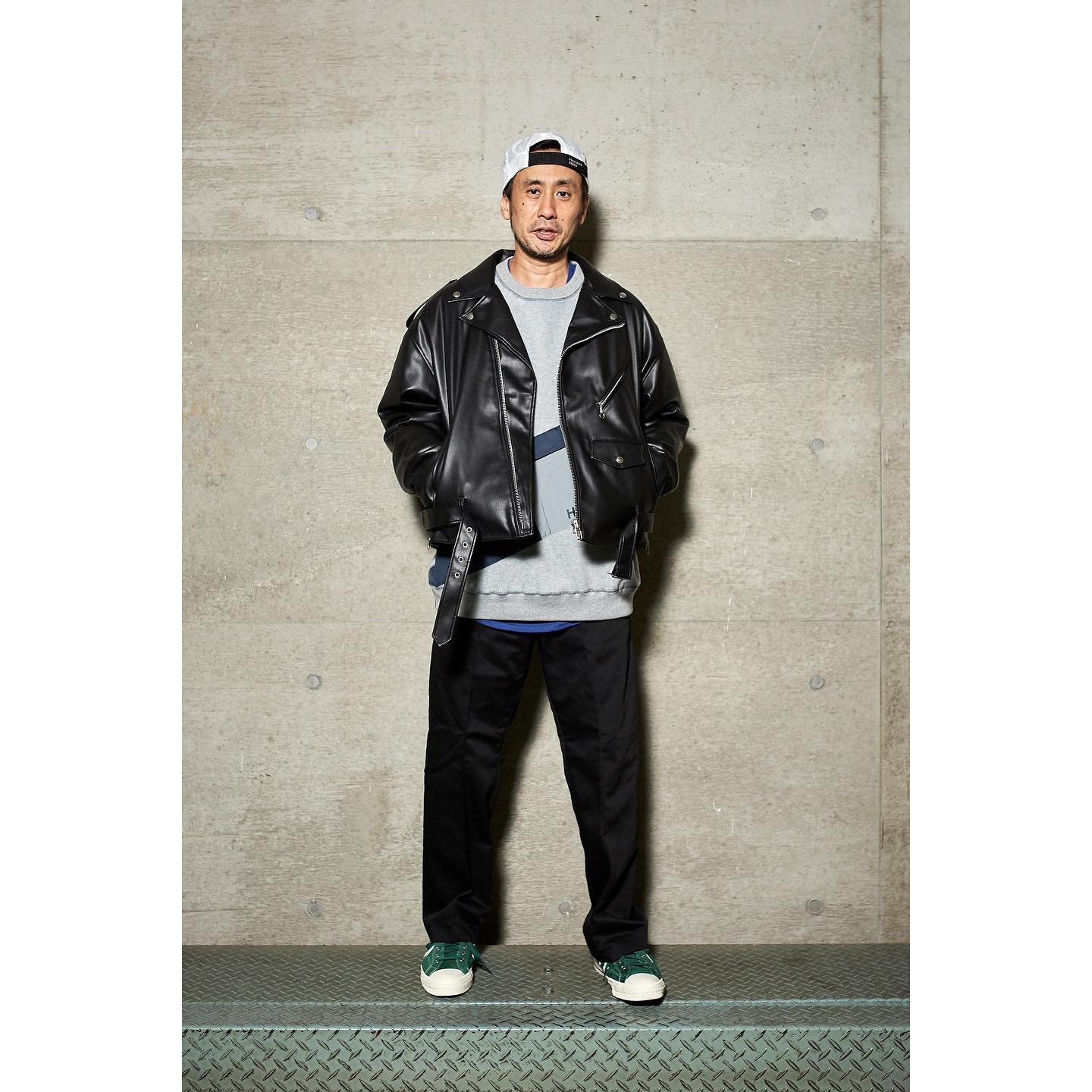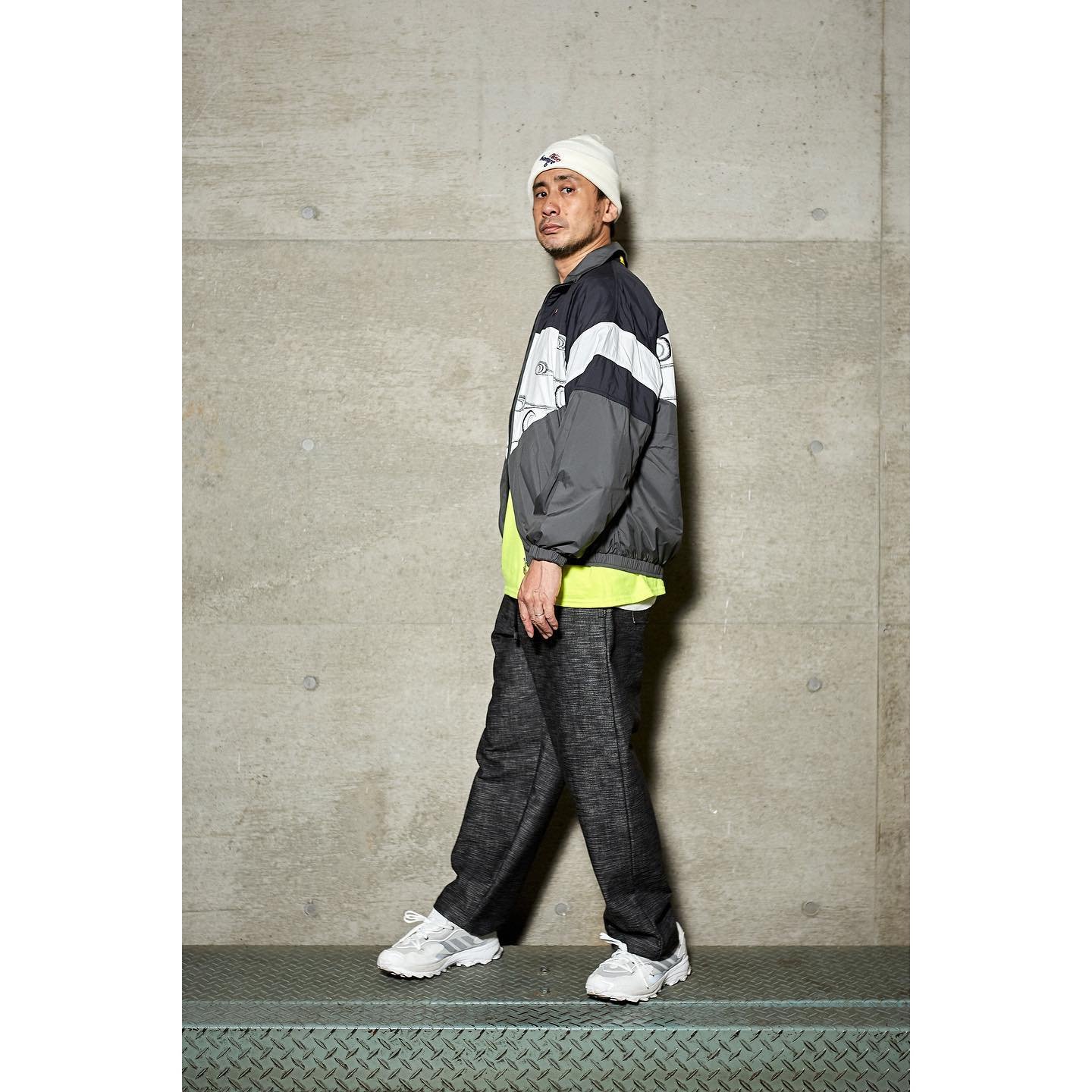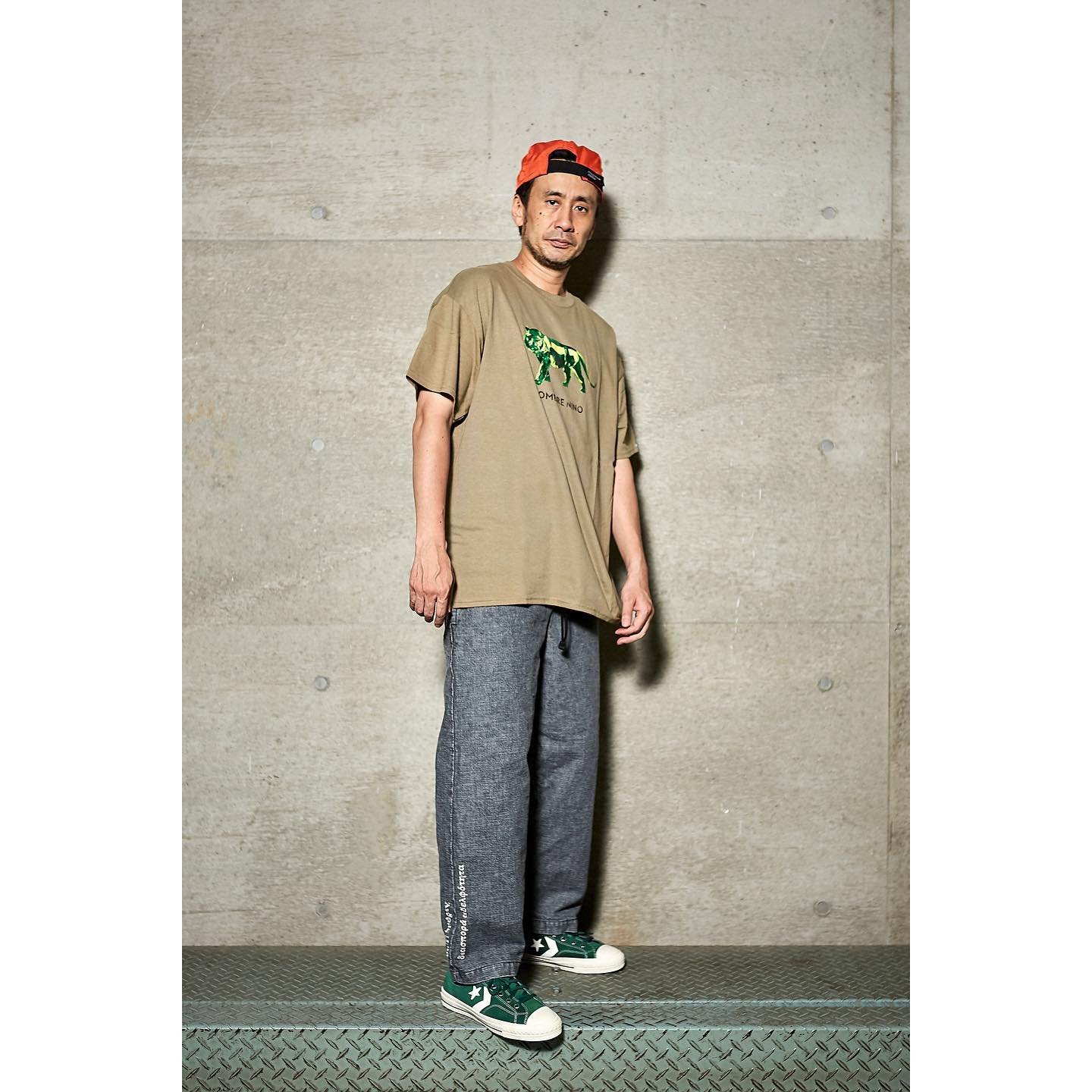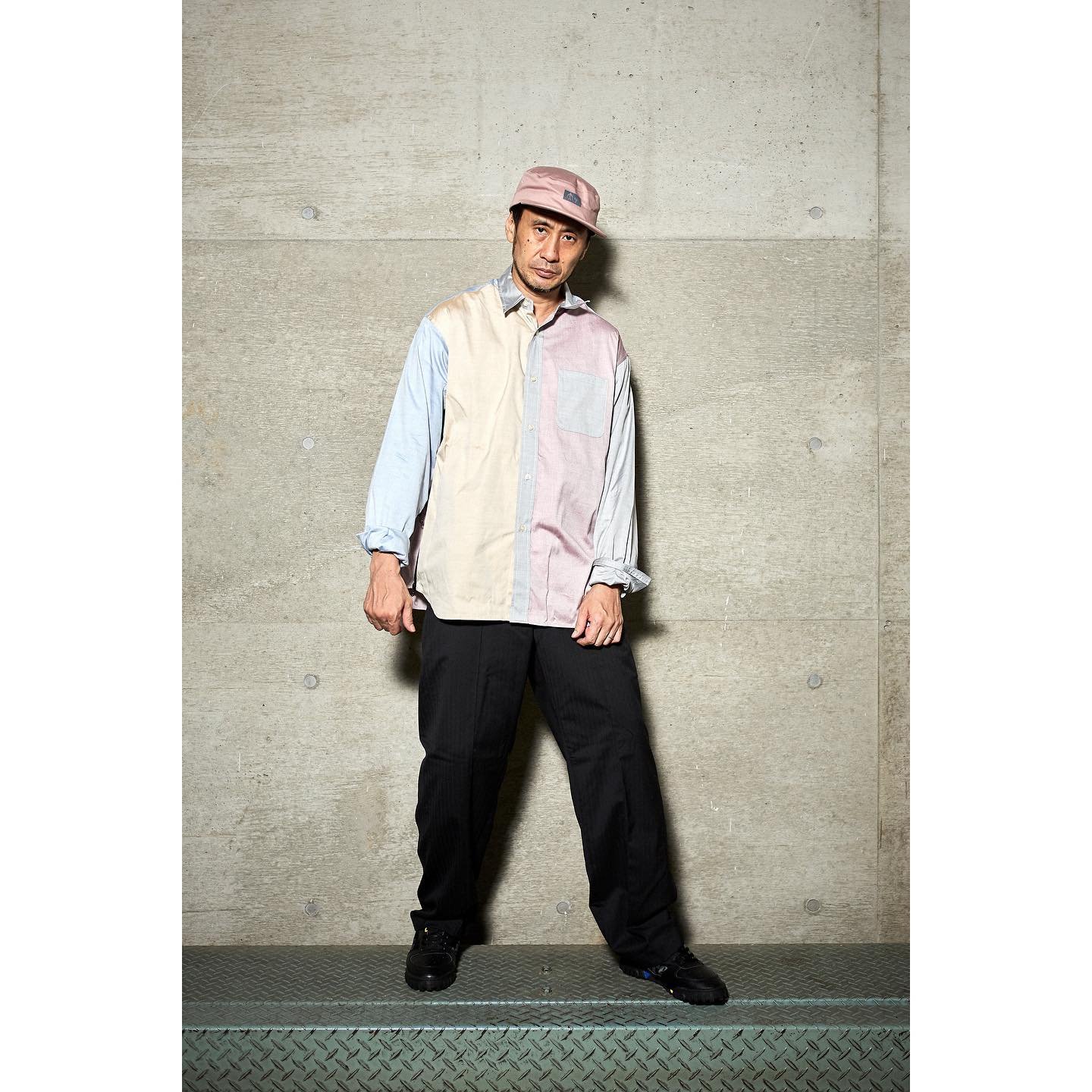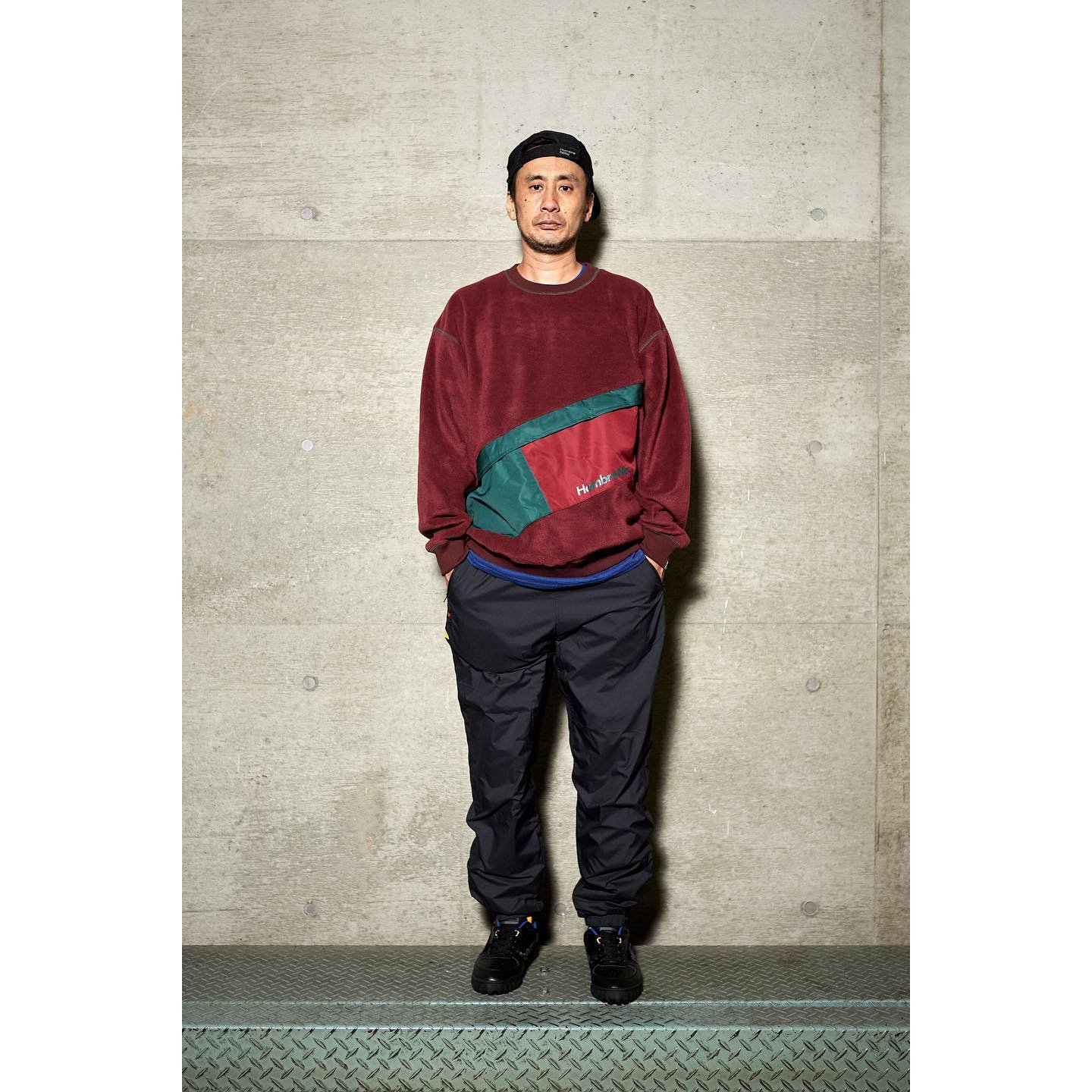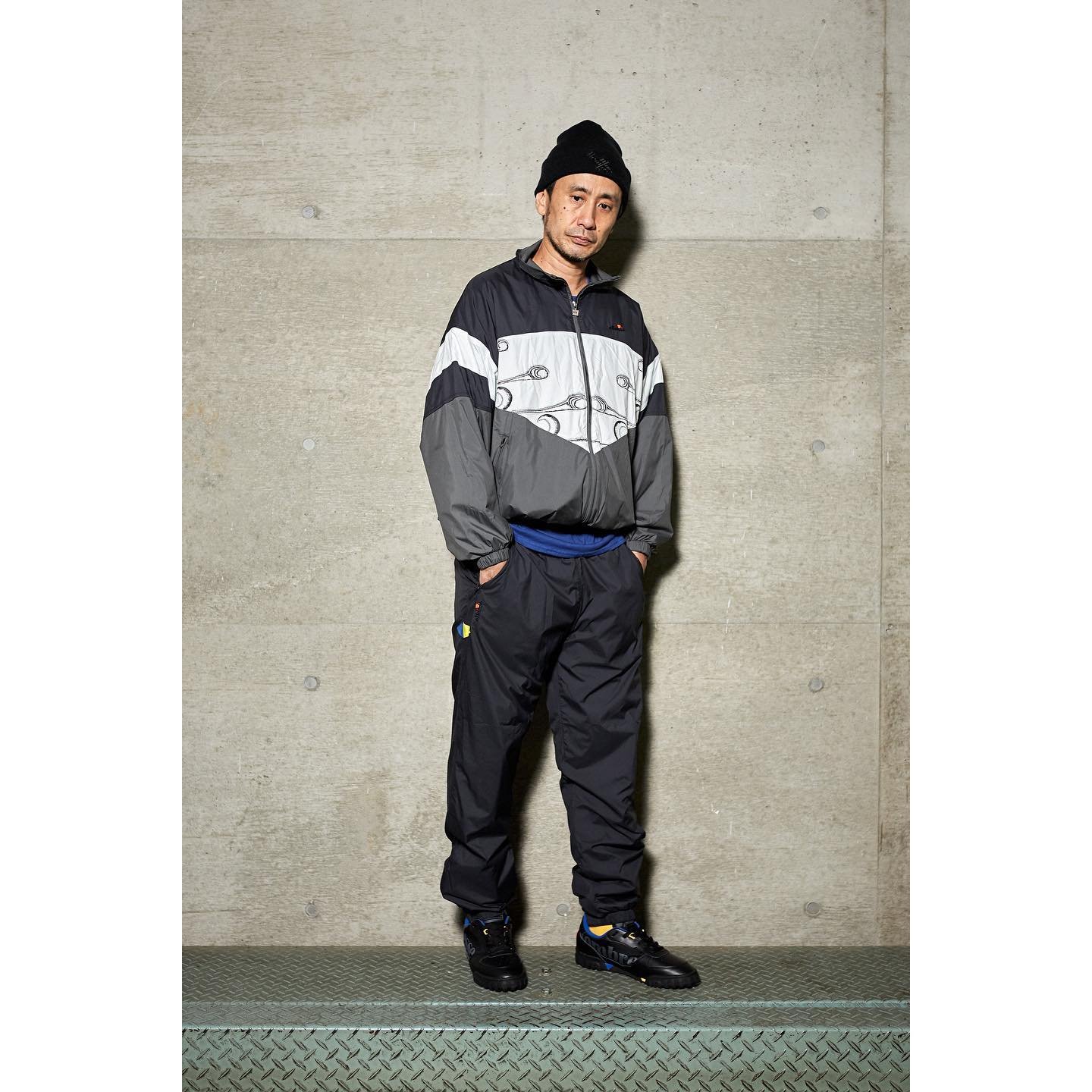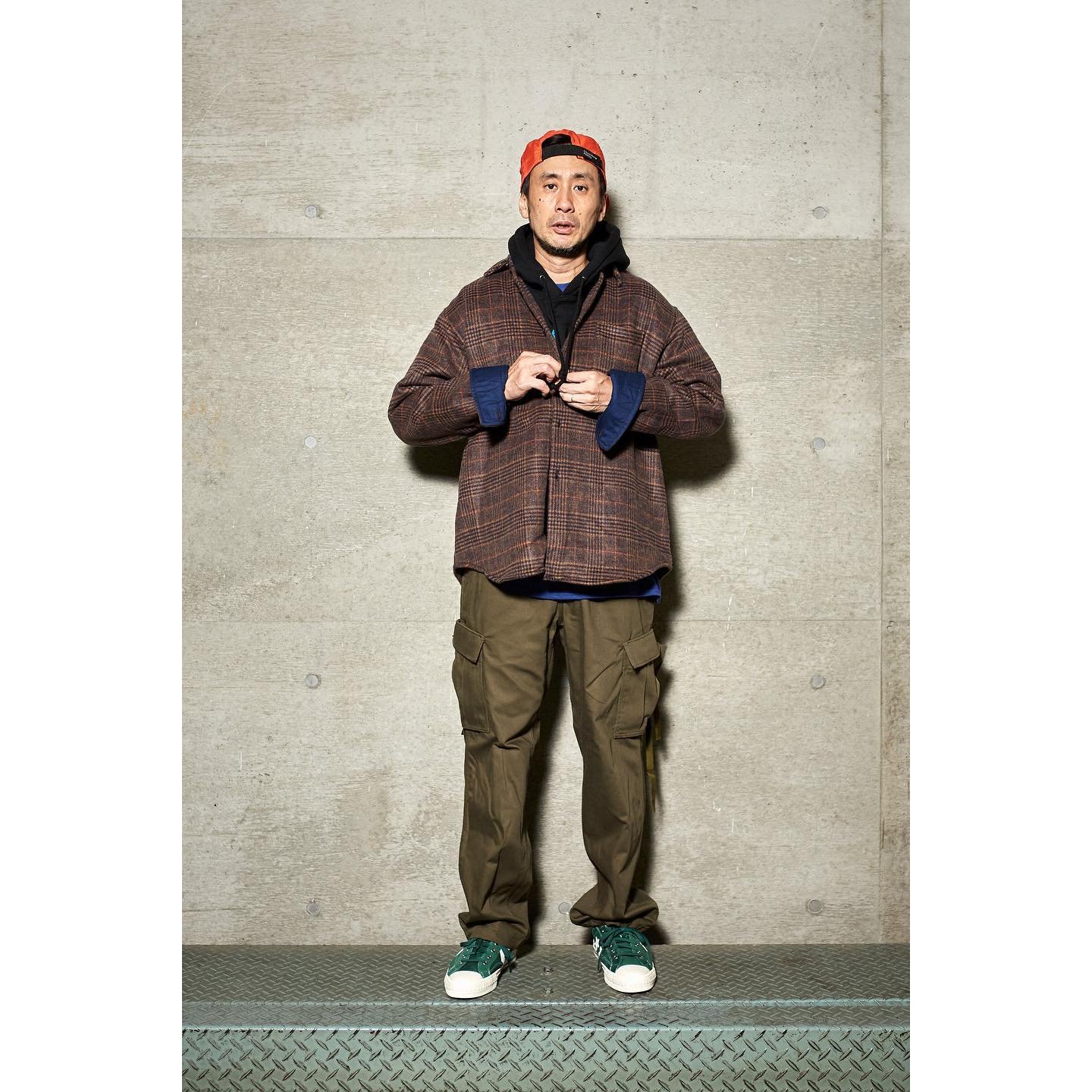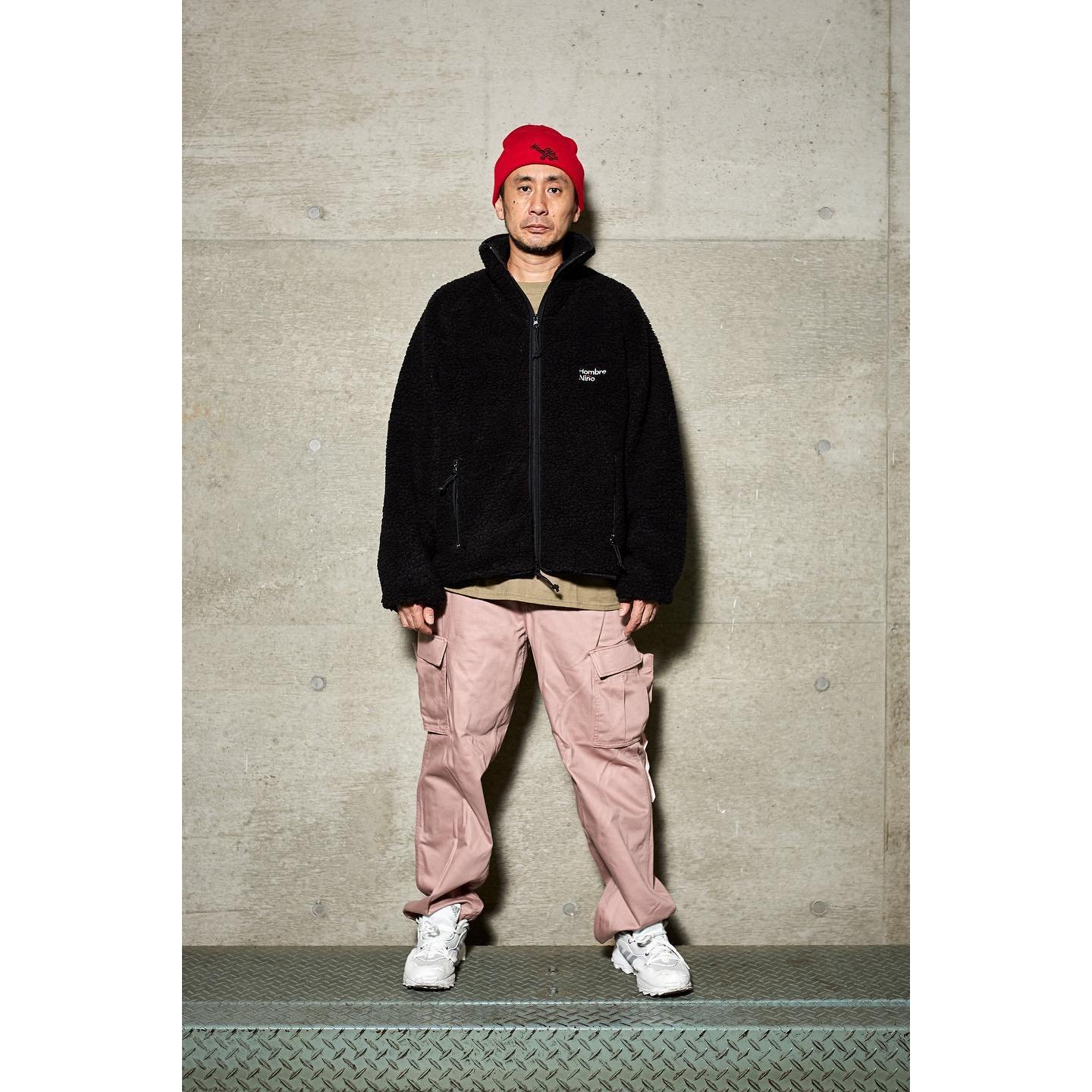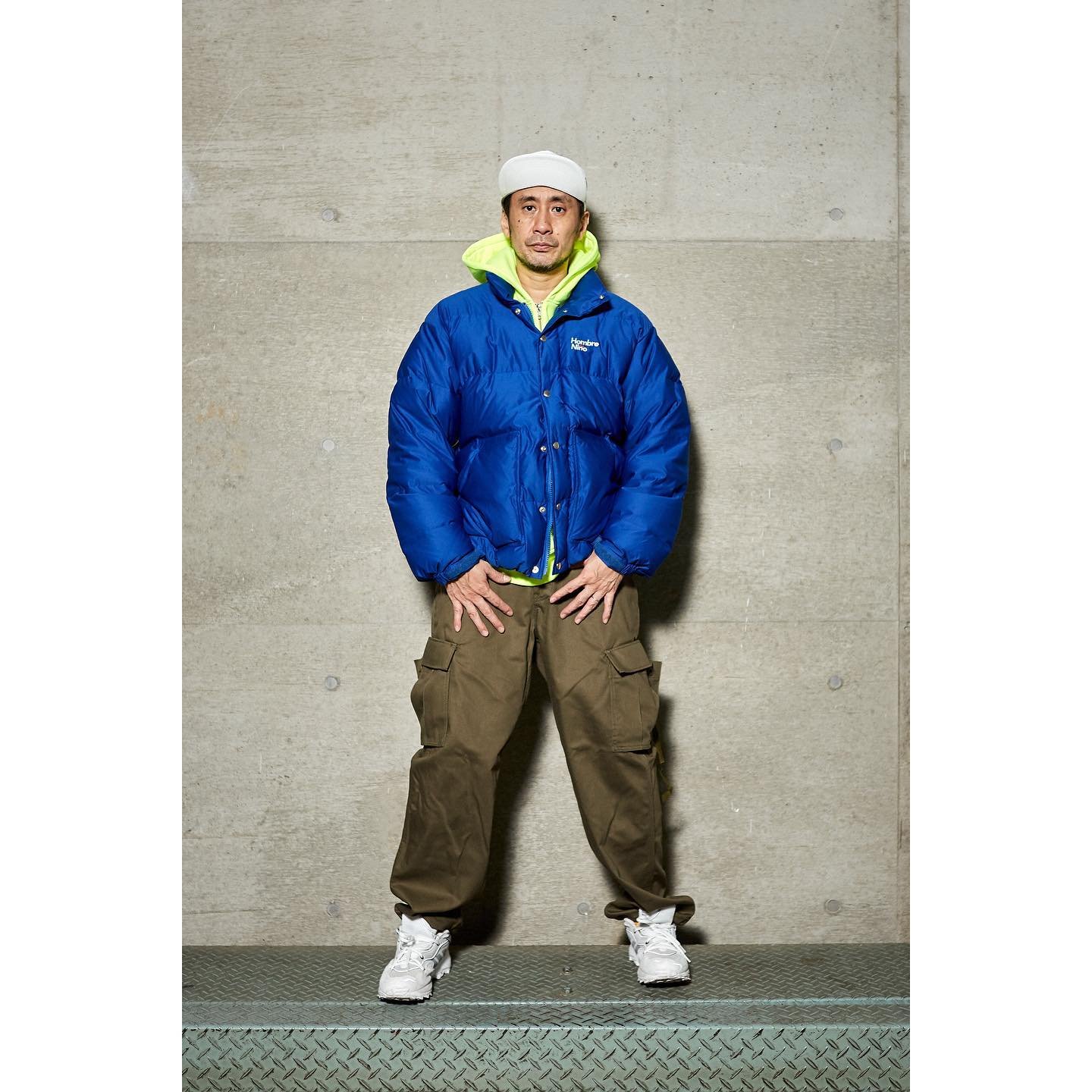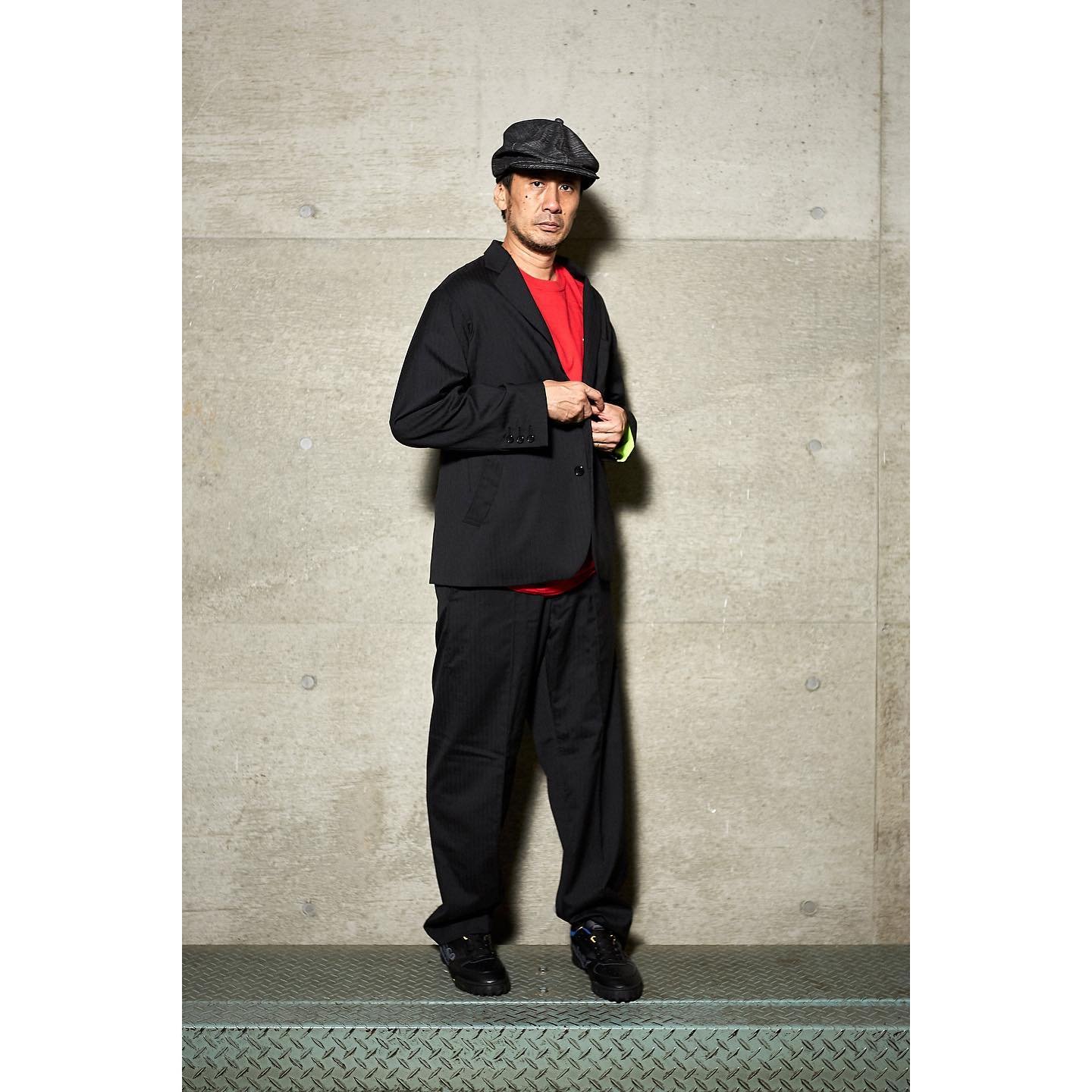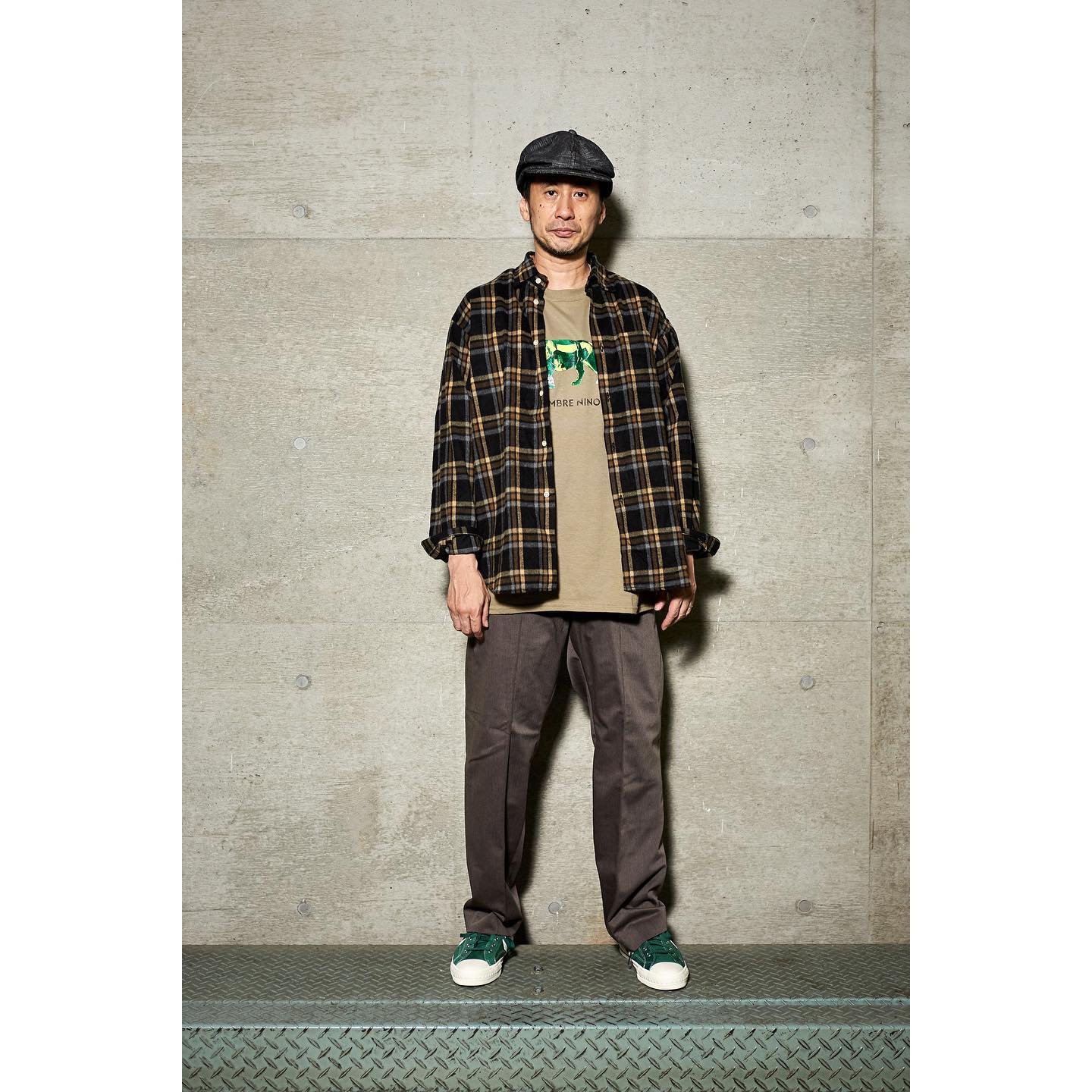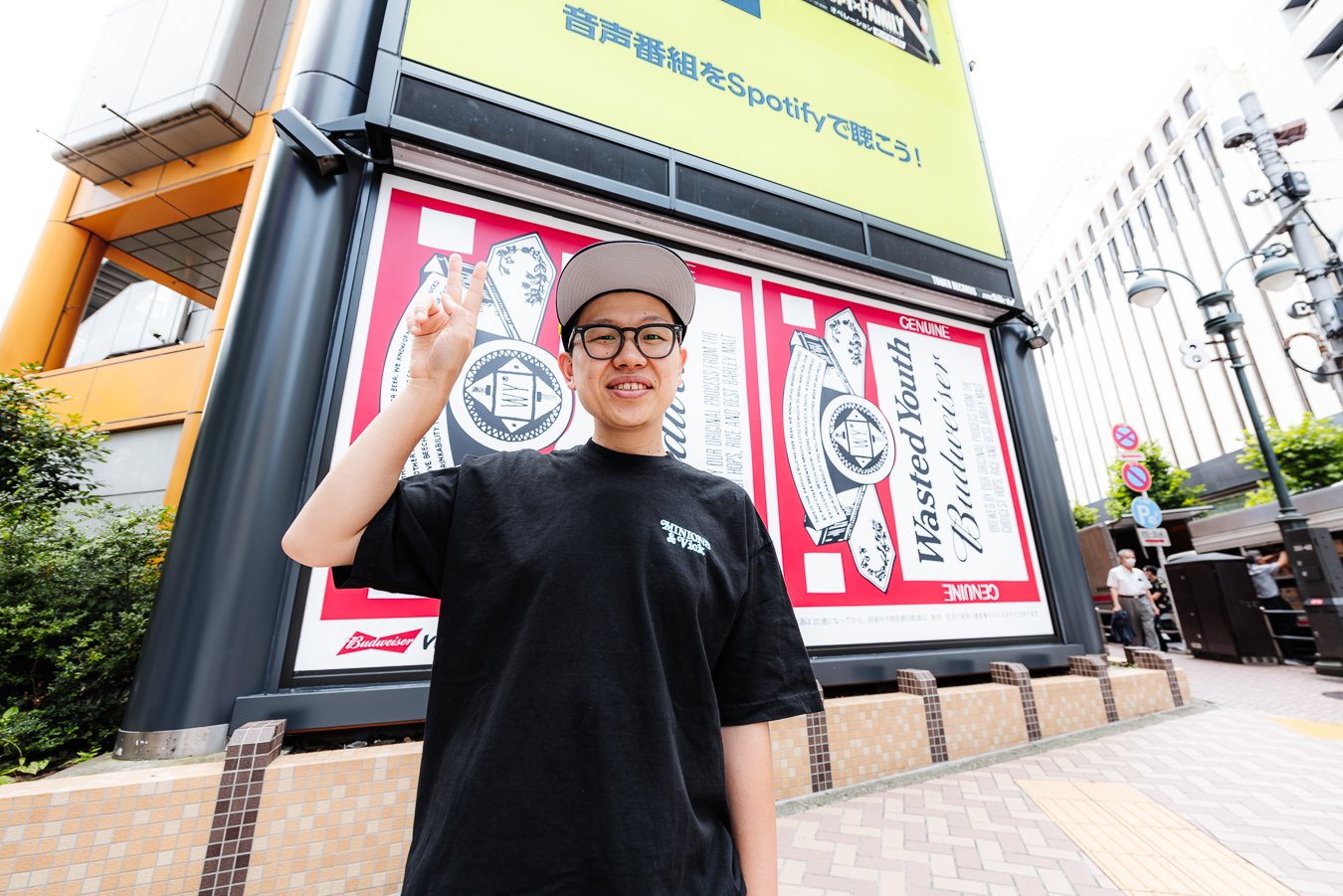SHAPING THE STREETS OF TOKYO - MEET THE URAHARA LEGEND YOPPI

Japan is one of the global epicenters of all things culture. From food to art, music to anime, some of the most influential and impactful things have come out of this country. Along with the endless list of subcultures that have shined here in Tokyo, one scene stands out to many of us, arguably the most important to ever see light: the street culture.
日本はカルチャーの発信地だ。食、アート、音楽、アニメ、他影響力のあるさまざまな文化がここで生まれている。どれも魅力的でファンの多いサブカルチャーだが、私たち、及びこれを読んでいる人の多くが特に好きで熱狂的になるものが一つある。ストリートカルチャーだ。
One of the things that solidified Japan’s status as a leading street country was the well known UraHara era. From the early 90s to the mid 00s, the UraHara era was not just a period of time but a scene, a community, and a whole culture itself. Brands like BAPE, UNDERCOVER, WTAPS and NEIGHBORHOOD all were born during this era, and expanded their horizons to the world to become who they are today. While these brands are some of the most iconic Japanese brands we know of today, at the time there were a countless number of labels and stores that were seeing the spotlight that never really made it out of the country.
日本はストリート大国だ。ファッションシーン、ストリートシーンに与えてきた影響は測りきれない。中でも、90年代初頭から00年代半ばまで続いた裏原宿、いわゆる「裏原」が日本を確立させた。裏原は単なる時代ではなく、一つのシーン、一つのコミュニティ、一つのカルチャーだ。今や誰もが知っているBAPE、UNDERCOVER、WTAPS、NEIGHBORHOODなど数多いブランドが裏原で生まれた。数十年の時を超え、これらは日本を代表するブランドとなっている。だが、当時は数え切れないほどのブランド、レーベル、ストアが裏原宿というとてつもなく濃いエリアに存在していた。海外で成功したブランドもあるが、その多くは国内のみで支持され、海を渡ることなく伝説となっていった。
Those of you fashion nerds might know some of these more low-key brands of the time. But most of the time even the biggest enthusiasts aren’t aware of the reasoning behind the success of these Tokyo brands. That comes to no surprise, as 99% of the information has never even made it out of Japan.
ファッションオタクは当時のブランドや店についてそこそこ知識があるかもしれない。だが、特に海外では裏原自体を知っていてもほとんどの人はなぜあそこまで大きくなり、今になっても語り継がれているのか、完全には把握できていないだろう。それもそのはずだ。当時はネットは今のように普及しておらず、もちろんインスタグラムもない。情報の99%は日本から一度も出ることなく終わってしまっている。
A key elements for a brand’s success today are their social media strategies. Influencers wearing certain pieces can decide the fate of an item, collection, or even the brand itself. But the UraHara era was much before Instagram or any other online platform became a part of the game. It was much more physical and direct, and people were directly influenced by people. Hiroshi “HF” Fujiwara, “2GO” NIGO, Jun “Jonio” Takahashi, it was names like them who impacted the entire generation of street kids.
時代は変わり、ブランドはSNSを通して世界に発信するのが当たり前な世の中になった。むしろインスタを使っていないと生き残れないと言っても過言ではない。インフルエンサーがアイテムを着用するだけでアイテム、コレクション、ましてはブランドそのものの運命が決まってしまうこともある。もちろん90年代にインスタグラムなどない。「インフルエンサー」という単語も当時は「?」だ。SNSが無い分、裏原はよりフィジカルであり、人は直接人に影響されていた。HF(藤原ヒロシ)、2GO(NIGO)、Jonio(高橋盾)といった人物が中心となり、ファッション、音楽、カルチャー全般に関して若者を率いてた。
But it wasn’t like now where everybody could see their favorite celebrities’ outfits. You couldn’t simply type in “@fujiwarahiroshi” on Instagram to see what they were doing that day. There were only a few ways you could actually find out what your idols were rocking: through magazine serializations like the “Last Orgy” series, going to parties, or luckily bumping into them in the UraHara neighborhood.
だが上記でも述べたように、好きな人の服装などを簡単にチェックできる時代ではなかった。@をつけて検索するだけで誰かの人生が覗き見できる時代が来るなど、当時は想像もしていなかっただろう。SNSがない当時、リスペクトしている人の情報を得る方法はとても限られていた。LAST ORGYなどの連載をチェックする時、パーティに行く時、もしくは裏原宿でばったり会えた時ぐらいだ。
One of these names you are guaranteed to come across from the UraHara period [if you do your research] is Egawa Yoshifumi, better known simply as “YOPPI”. From founding one of the era’s most important select shops/brand HECTIC, designing for his own brand Hombre Niño, modeling, a pro-skater & a member of the skate crew T19, being the center of Tokyo’s fixie bike scene & directing the iconic bike shop CARNIVAL, it might be harder to find something YOPPI wasn’t a part of at the time. He was even in some TV shows, commercials, and this iconic Snickers ad:
裏原時代を語る際、避けては通れない名前が一つある。「YOPPI」こと江川芳文だ。裏原宿を代表するセレクトショップ/ブランド「HECTIC」の設立者であり、Hombre Niñoのデザイナーであり、モデルであり、レジェンドスケートクルー「T19」所属のプロスケーターであり、ピストバイクショップCARNIVALのディレクターでピストバイクシーンの核心であり...むしろ彼が当時関わっていなかったことを探す方が難しいかもしれない。テレビやドラマ、CMなどにも出演し、どのシーンにも彼を知っている人はいただろう。
Take a look at any old street-related magazine, and you’re likely to find YOPPI in one of the pages. Whether it be as a model or as a designer/director, you can really see how big and how much of a legend YOPPI is. His brand [originally select shop] HECTIC saw great success, and was highly sought after by members of the UraHara community.
当時のストリート系のマガジンを手に取ってみるとYOPPIが載っていることが多い。フィーチャリングのされ方はモデルとして、デザイナーとして、スケーターとしてなどさまざまだが、とにかく彼の影響力を実感できる。YOPPIのHECTICも当時大成功し、裏原で需要の高いブランドの一つとなった。
To add to his already countless roles as a designer, model, director, store owner, he was also a professional skateboarder and member of T19, one of the Tokyo’s legendary skate teams. Alongside other members Hiroshi Fujiwara, SKATETHING, Hiroshi Otaki and more, YOPPI & his crew would open many doors, and introduce skating to the street scene of Japan.
上記でも述べたが、彼のデザイナー、モデル、ディレクターという幅広い経歴に加えて、T19(ティー・ナインティーン)所属のプロスケーターとしても活躍した。HF(藤原ヒロシ)、SKATETHING、OTACO(大瀧ひろし)らと共にT19は日本のスケートシーンに大きな影響を与えた。
Later on, YOPPI would open CARNIVAL, “the” spot in Tokyo when it came to fixie bikes. In fact, YOPPI himself was pretty much the reason why there was such a large fixie bike community in Japan at the time. Almost every name you can think of associated with UraHara got their bikes at CARNIVAL. Not only was CARNIVAL a place to buy bikes, it was also a go-to spot for the fixie community to just gather and socialize. CARNIVAL made fixie bikes so big in Japan, that at one point road bike riders and police would team up to try and get them off the streets.
数年が経ち、YOPPIは東京のピストバイクシーンの発祥の地の一つとなるCARNIVALをオープンした。YOPPIがピストバイクブームを起こした、と言っても過言ではない。裏原に関わりのあるほぼ全員がCARNIVALでピストと出会い、乗り始めた。だが単なる自転車屋さんではなく、CARNIVALはピストバイク好きが集まる場所だった。買って終わりではなく、乗り方を教わったり、最近の話をしたり、とにかくピストコミュニティの溜まり場的存在だ。コミュニティがどんどん大きくなり、いっときはカーニバルの両脇の道で警察が検問を行い、ロードバイク乗りと手を組んで取り締まっていた。
If this still doesn’t give you an idea of who YOPPI is and how important he is, we don’t know what to tell you. There is no one individual that has lived a life as unique and eventful as his.
これを読んでまだ「?」が「!」に変わっていない人はいないだろう。彼ほど重要で幅広く活躍した人はそういない。
But for the most of you who have realized how legendary he is, we bring you good news. The Sabukaru team was lucky enough to be able to sit down with YOPPI, and talk about the things that haven’t made it out of Japan, the things that even Japanese people don’t know. Check out what he had to say below.
ほとんどの人はここまで読んでYOPPIという人間のインパクト、影響力を把握できただろう。SabukaruチームはYOPPIさんに直接会い、インタビューをさせてもらった。まだ日本から出ていない情報、日本人ですら知らない話を聞かせてもらった。
We always start with the same question, could you please introduce yourself to the Sabukaru Network?
はじめにSabukaruネットワークに自己紹介をお願いしてもいいですか?
My name is Yoshifumi Egawa, I’m 49 and I run a brand called Hombre Niño, design for XLARGE, and do distribution for skateboards. I’ve always had a select shop mindset, and that's pretty much how I work right now.
芳文江川です。年は49歳で、今はHombre Niñoというブランドをやっていて、XLARGEのデザイン、スケートボードのディストリビューションもやっています。まあ割と昔からセレクトショップ気質の頭の考え方かなって感じで、いまもそんな感じで仕事しています。
When would you say you gained your passion for streetwear and street culture?
ストリートカルチャーに興味を持ち始めたのはいつごろですか?
I started skating and going to Harajuku often when I was about 13. I would always go to a skate shop called STORMY. From that point on I basically dove into Harajuku culture and it kind of became my lifestyle. I’d say from around 9th grade I would always be in Harajuku hanging out with my street friends. I never really hung out with my school friends. Those people I met in Harajuku at the time are the people I still associate with.
13歳でスケートボードを始めて、同時期に原宿に通い始めて。そこでストーミーというスケートショップに行き始めてそこからが割と原宿カルチャーじゃないですけど、原宿に通う生活が始まりました。中学三年生くらいかな?学校の友達とは全然遊ばないで、原宿に行ったりして。14歳くらいですかね。そこで当時出会った人たちが今でも付き合いがある人たちですね。
Image via YOPPI’s Instagram
Was the scene smaller back then?
当時のシーンは今に比べるとまだ小さかったですか?
Yeah, there were really only two skate shops at the time, Murasaki Sports and STORMY. I started working part-time at STORMY when I was around 15, and ended up building a lot of people’s decks and would exchange information with them there. There was a café around the corner in front of Laforet and that was the place for people in the scene to hang out. Also from Inokashira-dori till Yoyogi became a pedestrian zone on Sundays so we would all skate there and that's where I met fashion models, MILKBOY, Jun “Jonio” Takahashi of UNDERCOVER, and Hiroshi Fujiwara as well.
そうですね、スケートショップがムラサキスポーツっていうところとストーミーっていうところの割と二極だったんですよ。その二つしかなくて僕はそのストーミーで15歳でバイトし始めるのかな?そこからすごい色んな人の板を組んだりとか、情報交換をしたりとかして。で今のラフォーレの前の角がカフェだったんですよ、そこが社交の場になってたりしてたんですよ。井の頭通りは日曜日は歩行者天国になるんですけど、そこでスケートボードしたり、代々木の方までずーっとホコ天で、そこでファッションモデルやMILKBOYの大川ひとみさん、UNDERCOVERのJonioさんや藤原ヒロシさんに出会いましたね。
What made you want to become independent after working at STORMY?
ストーミーでのバイトから自分で何かをしよう、と思ったきっかけはありますか?
I’d say the biggest turning point was when I entered a skating competition in San Francisco in 1991. I had briefly understood since I was a kid that because Japan is an island country, you really need to go to the States to understand US culture. Since skateboarding culture was big in the US, I needed to go to the US if I really wanted to make it as a pro skater. At this competition called “Back To The City”, just seeing the overall vibe, the girls, and people of all different races was incredible and became a big turning point for me. As I participated in the competition, I would check out who was wearing what shoe, the styles of famous skaters and their girlfriends, it was like my eyes were constantly taking pictures of every scene I saw.
一番のターニングポイントは、91年にサンフランシスコの大会に一人で出た時ですかね。日本は島国だからどうしてもアメリカの文化のものは向こうに行かないとわからないし、スケートボードのプロになっても生活できないというのはなんとなく子供の頃からわかっていて。で、その時のBack To The Cityの大会の雰囲気やその大会にいる周りの女の子だったり、それこそ色んな人種の人たちを見るんですけど、その感じがたまらなくて。それがターニングポイントになって、大会に出ながら色んな人のファッションチェックしてて、誰がどの靴履いてて、あの有名なスケーターの彼女のファッションかっこいいなみたいな、もうずっと目がパチパチシャッター切ってる感じでした。
In terms of street and skate culture, what was the first project you started on your own?
ストリートやスケートカルチャーでYOPPIさんが自ら始めた最初のプロジェクトはなんですか?
Hitomi Okawa from MILKBOY reached out to me to start a brand, and that was my first project. The brand was called YTPO and it was a line under MILKBOY.
ミルクボーイの大川ひとみって方がいるんですけど、その人がきっかけでブランドをやらないかと誘われたのが一番最初でした。YTPOっていうミルクボーイの中の別ラインで。
Prior to starting YTPO, did you have any fashion education or experience?
YTPOを始めた頃、服作りを学んだり経験はありましたか?
No, not at all. Everything was all self-taught.
いえ、全然なかったです。独学です。
What was YTPO short for?
YTPOはなんの略だったんですか?
I didn't really understand much at the time, so it wasn't really me who named the brand, it was Okawa-san. Y was for YOPPI and we decided to go along with my TPO [time, place, occasion], so that's how it was named.
いや全然本当になんにもよくわかってなかったので、僕がつけたというよりは大川ひとみさんが付けた感じなんですよね。YがYOPPIで、そのYOPPIのTPOで作って行こうって感じですね。
How did this connect to PKG?
そこからどのようにしてPKGに発展していったのですか?
I was about 22 when I was working on PKG, and 19 when I was doing YTPO. After YTPO ended I quickly started a brand called REGULAR with three of my friends. I think that was around 1993, and HECTIC also started around 1993 even though to the public we said 1994. Co-founder Magara-san’s friend lived in New York, and we had him send a list of cool English terms. One of them was HECTIC, and that’s how we got our name.
A bit later, HECTIC slowly started becoming busy, and at first we stocked REGULAR too. But this gradually came to an end, and we fully moved on to focus on HECTIC. At this point HECTIC was just a select shop. We would go to Boston and New York about twice a month for buying purposes and slowly became more and more tired. So I would stop by arcades in Harajuku to play Street Fighter and Virtua Fighter. The buttons for those games were punch, kick, and guard. Magara-san said PKG is a good name, and we went with it.
PKGは22歳ぐらいにやって、YTPOはまだ19とかの頃でした。YTPOが終わってすぐレギュラーっていうブランドを作ったんですよ。友達3人ぐらいで。それが93年かな?でHECTICが動き出したのも93年で。表向きには94年なんですけどね。HECTICで一緒だった真柄さんの友人がニューヨークに住んでいた、お店の名前候補としてかっこいい英単語をリストアップしてもらったんですよ。その中の一つがHECTICで、それに決めました。
そこからHECTICが段々忙しくなって、最初はレギュラーも扱っていたんですけど、徐々にHECTICに移行していった感じですね。HECTICはあくまでもセレクトショップだったんですよ。で、月に2回くらいボストンやニューヨークに買い付けに行っていて。でちょっと疲れ始めて、原宿で仕事帰りにゲームセンターでストリートファイターとかバーチャファイターやってたんですよ。あれのボタンがパンチ、キック、ガードで。一緒にHECTICを設立した真柄さんがPKGいいじゃん、って感じになってそのまま名前にしました。
Within the Tokyo street culture scene and UraHara, what phase was 1993?
93年という年は日本のストリートシーンや裏原の歴史のどのくらいの時期にあたりますか?
It was still in the early stages. There was basically nothing, not even Supreme yet. Right around the time when NOWHERE, NEIGHBORHOOD and 40 PERCENT were starting up. The road around what is now Supreme Harajuku became a place for people like us who wanted a chance to start an independent store. More and more people would see this, and would also open their own stores. The street was originally a street filled with vintage stores, so everyone fit right in.
多分前半ですね、まだ全然何もなくてシュプリームとかもなくて。まだNOWHEREとかネイバーフッドや40パーセントとかができたばかりの頃ですね。今のシュプリーム原宿店を基本とした道に僕らみたいなインディペンデントなお店が入って、「あそこ開けたんだ、じゃあ俺らも開けよ」みたいな感じで場所としてはあの道がやりやすかったというか。元々その道が古着屋さんの通り的な感じだったんですよ。
What was the atmosphere in Harajuku like back then? Why were people attracted to Harajuku?
当時の原宿の雰囲気はどんな感じでしたか?なんで原宿に人が集まり始めたんですか?
Before us, there was store called LONDIS in a hidden ally behind where FTC is today. I kind of liked the idea of a small store that is hard to find, and at that store I was heavily influenced by SK8THING and he became the center of everybody, and attracted a lot of people around him. This led to everybody opening stores in what is known as UraHara today. Everybody opened their stores one by one and it was a friendly atmosphere even though it usually would be competitive. Maybe we were too childish, too friendly [laughs]. Then Hiroshi Fujiwara put everything together in one and solidified us as a culture. He was very talented in conveying, he had this literary talent like no other.
その前にロンディスというお店が今のFTCの横の道入った裏側にすごくわかりにくい場所にあったんですけど、そのちょっと探さないと辿り着けない小さなお店に夢を抱いていたというか。スケシンさんにすごい影響されて、彼の周りには色んな人が集まっていく軸があって、そこで今裏原と呼ばれている通りに仲良くお店を一つずつ出して行ったんです。そっちやるんだったら俺こっちみたいな感じで。普通は競争するはずなのに僕らは子供っぽかったというか仲良すぎたのかわからないですけど(笑)。そこで藤原ヒロシさんがひとまとめに文化として、こう発信能力というか、文才があったんじゃないかな。
Even back then, did Hiroshi Fujiwara stand out, was he well-respected?
やっぱり当時藤原ヒロシさんは他と違うオーラというか、リスペクトされた存在でしたか?
Yeah, I think the biggest factor was that everybody wanted what he would wear. It’s very simple and I was influenced by this as well. He was a DJ and did a lot of different things too, but the biggest factor was wanting whatever clothes or shoes he was wearing. Obviously there are other factors like his DJ mixes being clean and all, and everything kind of connects together, but what he was wearing is ultimately the biggest factor.
一番の決定的な要因はやっぱり藤原ヒロシさんが着ていた洋服をみんな欲しくなる。単純なんですよ、それだけしかないんですよ。僕はそこに影響されてて、ヒロシさんがDJとか色々やってたんですけど、ヒロシさんが着ているもの、履いているものが欲しい!ってなっちゃった一人なんで。結構みんなそこなんじゃないかな。もちろん色々他もあるんですけど、やっぱりそことあとDJのミックスが綺麗なところ、全部がトライアングルになって重なっていって。でもやっぱり着てる服が一番大きい。
Hiroshi Fujiwara [left] and YOPPI [right]
When we take a look at old magazines, you pop up everywhere. What was your connection with things like Last Orgy and Hiroshi’s many brands?
昔の雑誌を見ているとYOPPIさんがよく出てきます。当時のLAST ORGYやヒロシさんの数多いブランドとはどういった関わりだったのですか?
I guess they were kind of like friends who I would skate with.
スケートボードを一緒に滑る仲間的な感じですかね。
One of our favorite Last Orgy III volumes is when you guys all went to Fuji Q Highland. How did that happen?
私たちが特に好きなLAST ORGY IIIで富士急ハイランドに行く回があったと思うのですが、どういう流れであのメンバーで富士急に行くことになったのですか?少しお話しを聞かせてください。
They just asked me if I wanted to tag along with them like if we were to skateboard. I went because it just founded fun!
スケートボードを一緒に滑る様な感じで誘われました(笑)。単純に面白そうだったので付いて行きました!
In terms of the brands you did in the 90s, what style of clothing were they?
当時90年代にやられてたブランドはどんなスタイルの服が多かったですか?
It’s always been the way it is [laughs]. When I started PKG, I made a chambray shirt and the factory I used for that shirt is connected to the factory I use currently so it really hasn't changed much. So, we often collaborate with a brand called CORONA, and the factory for that is also connected with the factory for PKG.
お恥ずかしいですけどずっとこんな感じです(笑)。しかもPKG始めた時シャンブレーのシャツ作ったんすけど、それ作った工場も今作ってるところと繋がっていて。ずっと変わってないですよね。だからそのコロナというブランドとよくコラボしているんですけど、そこのブランドの工場もPKGの工場と繋がっていて。
What's the most important factor for you when making clothes?
YOPPIさんが服を作る上で、一番大事にしている要素はなんですか?
In terms of what I focus on, I always say retro and new. I combine retro and new into something people haven’t seen even if it’s by misunderstanding or it just that it looks that way. Basically it’s casual wear and I know it can be labeled as bicycle wear or skate wear and what not, but to sum it up it is outdoor casual wear that is made for life in the city. If I just say it’s an outdoor brand, we can’t compete with other brands [laughs].
意識しているのはよくレトロ&ニューって言ってるんですけど、レトロなものと新しいものの感覚をこう勘違いでもいいですし、そう見えたというだけでもいいですし、まあ見たことない感じに持っていけたらいいな、っていう感じです。まあ基本カジュアルで自転車とかスケートボードウェアとか色々言い方あると思うんすけど、大くくりはカジュアルの東京というか都会ベースの服です。わかりやすくいうと都会をベースとしたアウトドアカジュアル的な感じだと思います。アウトドアって言ってしまうと僕ら敵わないんで(笑)。
Has this not changed till this day?
それは今も変わらないですか?
Yeah, nothing’s changed. Like this shirt, there are zippers on the arm pits because I walk a lot and when you walk from your home to the station and get on the train you're already drenched in sweat, even during the winter because the train is so hot. So I kind of think of these functions off of that mindset. I try to make sure that my life doesn't become too easy. Once a brand grows, you tend to move by car a lot, so in order to think of these functions for riding bikes or motorcycles, I try to not live day by day too comfortably.
変わらないですね。東京生活でこの脇のこのシャツのチャックとかもそうですね。結局よく歩くんで、僕。家から駅まで歩いて電車乗ったらもう汗だくでしょ、冬場でもここ空いていたらいいな、そういう発想でやってます。あんま楽になんないようにというか、ブランドばっか成熟していくと車とかばっかになっちゃうんで。自転車とかバイクとかバイク乗るための防寒具とかそういう発想だったりとか、だからなるべく楽にならないように自分はそういう生活をしながら、今はそういう感じ。
Speaking of bikes, how did Carnival start?
自転車つながりでいくとカーニバルの原点は?
So I spent a large amount of time skateboarding in the 90s, and HECTIC was starting to become increasingly busy to the point where it became difficult to balance the two [but that didn’t stop me from skating]. Then in my 30s, this guy called Jovantae Turner released a video of him wheelieing around a corner. This left me in awe and was the spark of my passion for BMX. From the perspective of a BMX rider, people that ride road bikes look kind of frail, but every autumn I would have this urge to buy a bike and wanted a new one, so I bought a road bike influenced by friends. This was around the same time I saw the Jovontae video and I was wondering what type of bike he was riding, and found out it was a fixed gear bike. This opened my horizon for bikes, and I first wanted to find out what a fixie bike really was. So I talked to my friends about fixed gears, we were still newbies at the time. This led to us making our bikes single free and learning more about what fixed gears were. Then I became connected with a messenger in Tokyo who would always place 1st or 2nd in races, and I was able to get frames for cheaper and have access to the parts that aren’t on display usually.
This started my love for fixie bikes, and I wanted to wheelie but I was too afraid to go out in the streets with no brakes. So my friends and I started with both brakes, took one off, and then both. I would always practice wheelies, but since I didn't have a teacher I pushed it too much and hurt myself. And then my obsession with Italian frames and Italian biking culture kicked off. I was very much into Italian bikes like the Campagnolo, the designs and next thing you know I went to Italy for buying purposes which led to the start of CARNIVAL.
T19

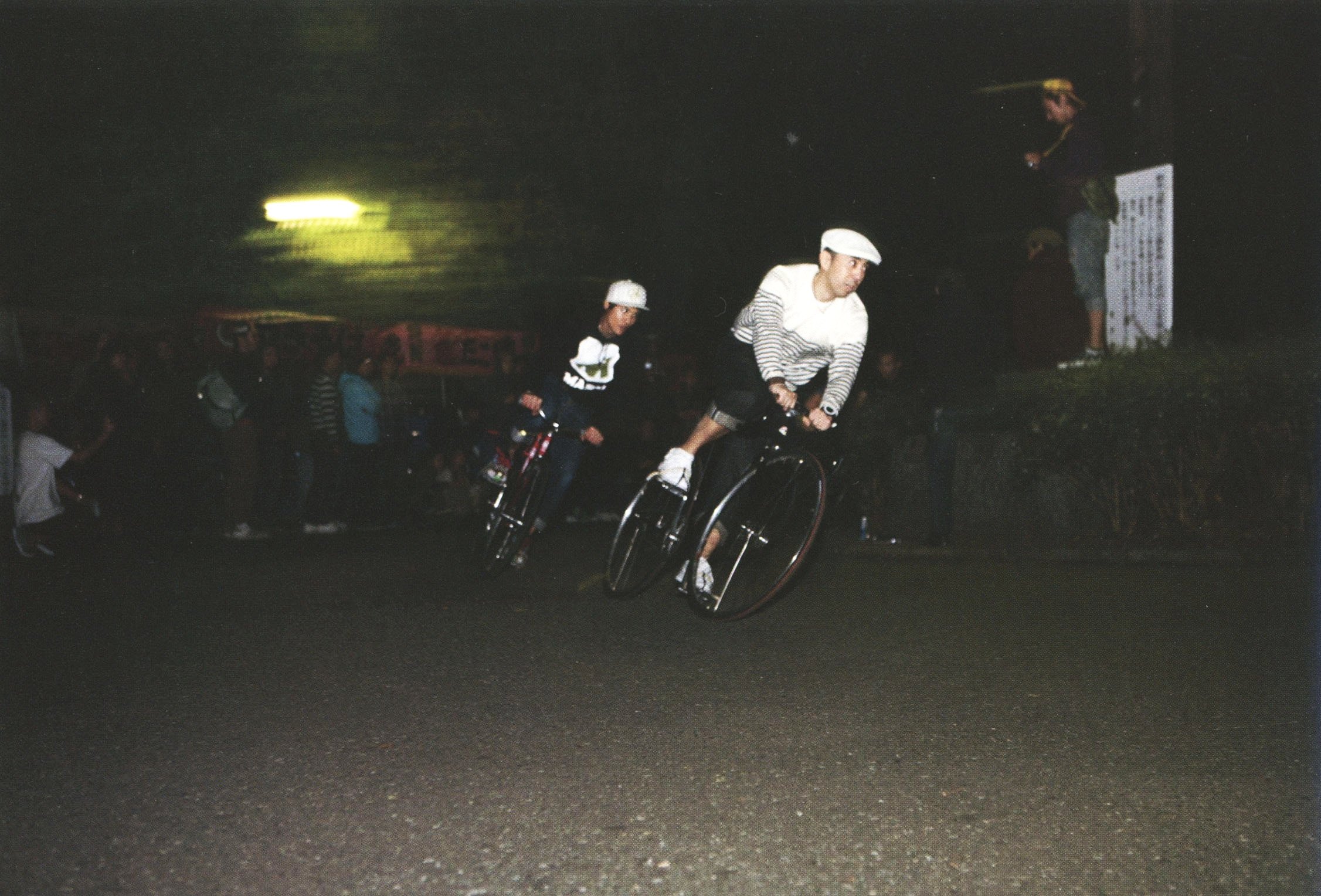
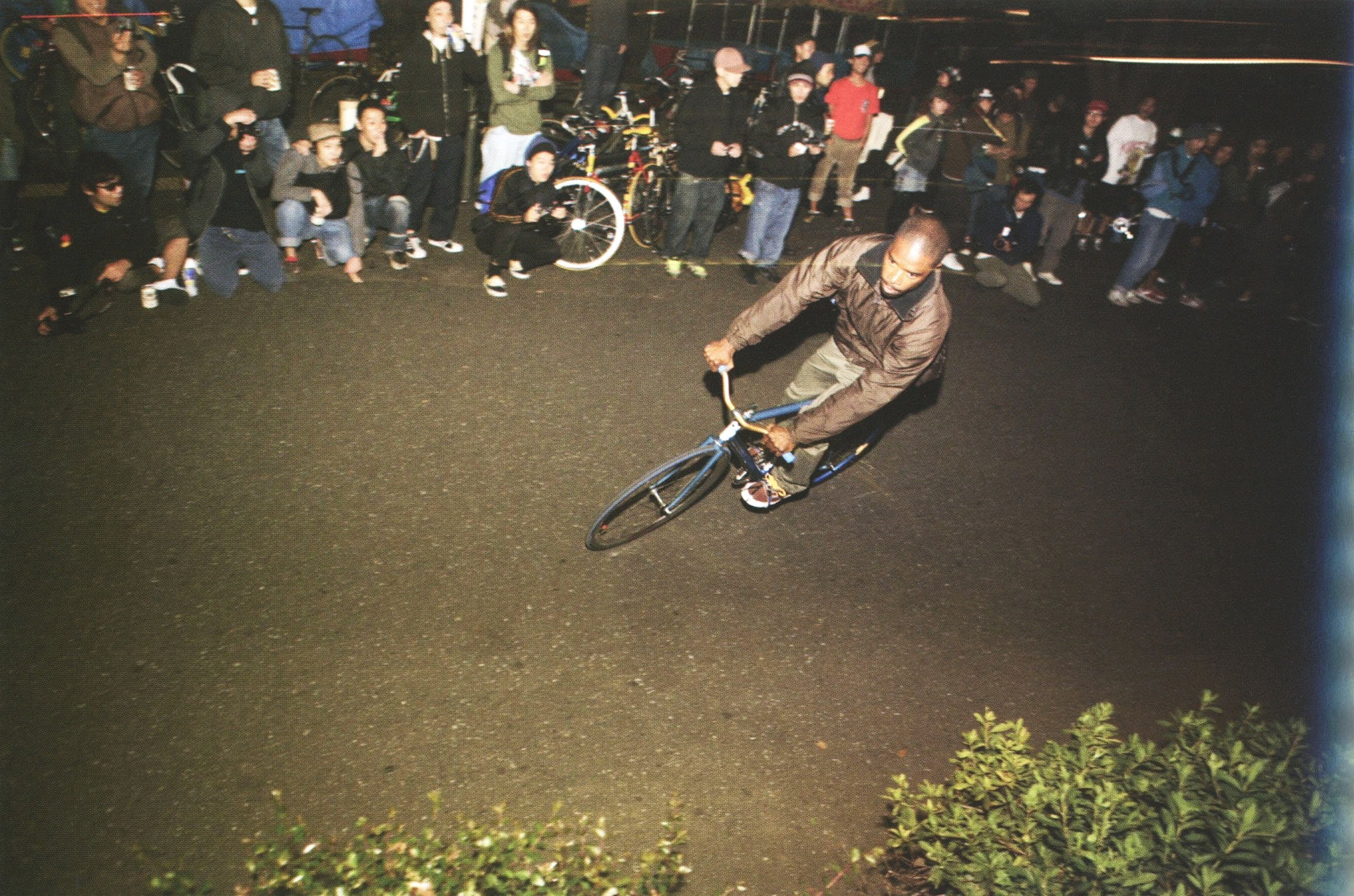
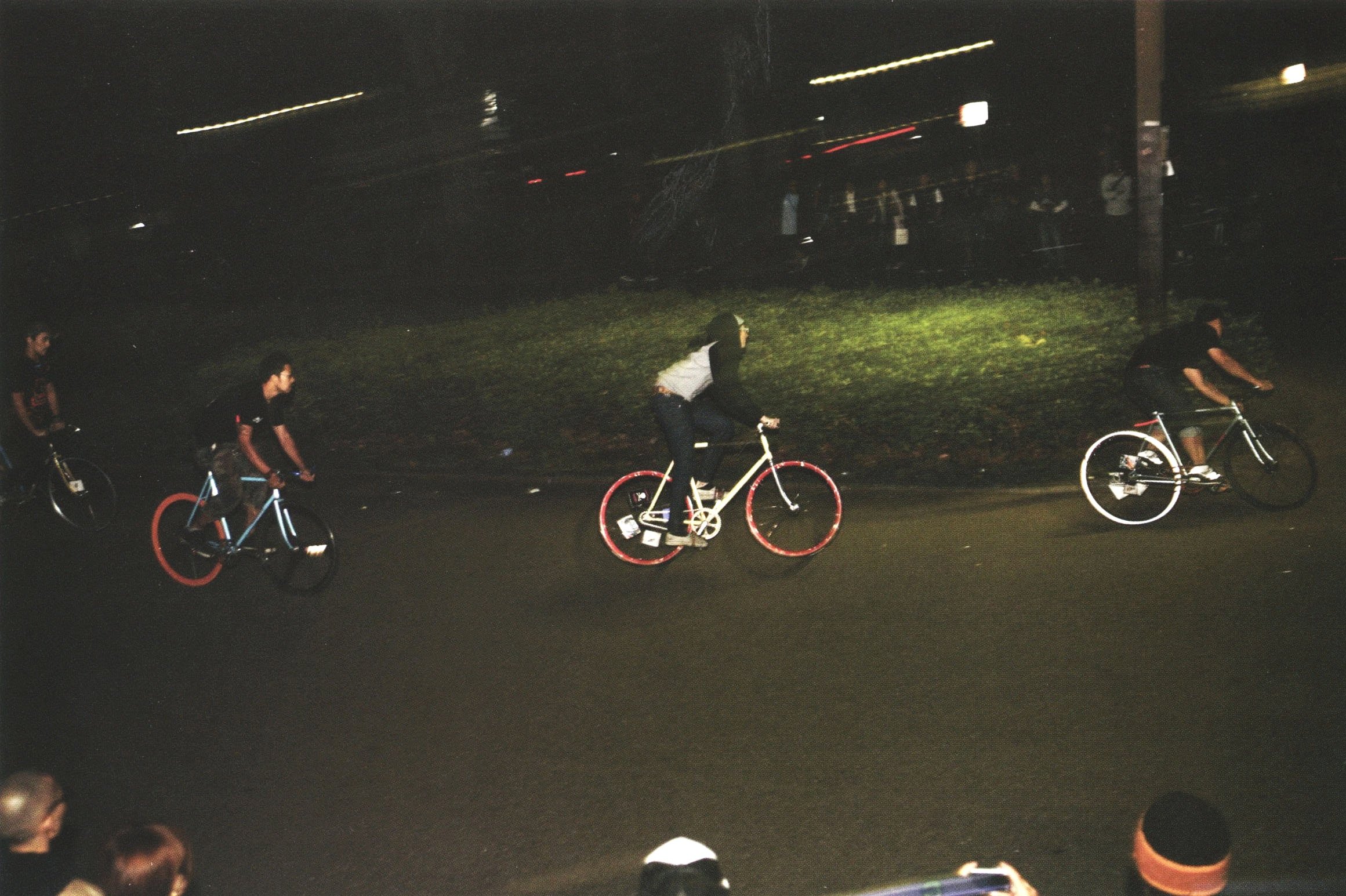
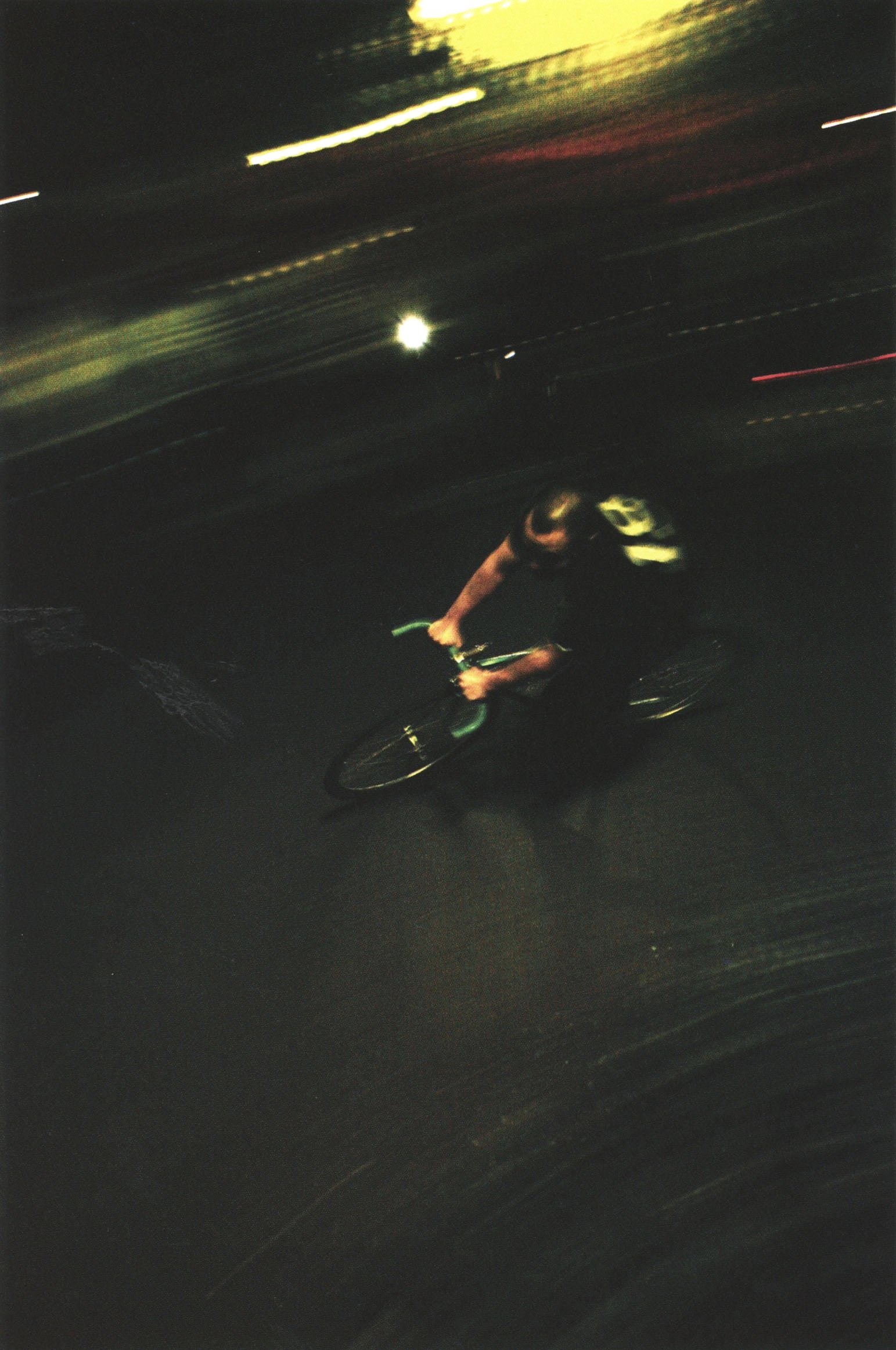
カーニバルは、20代に割とすごい時間をスケートボードに費やしてたんですけど、20代前半でHECTICがどんどん忙しくなってスケートボードと平行するのが難しくなって。まあ続けてたんですけど(笑)。そんな中30すぎてからジョバンテ・ターナーって同世代の人がウィーリーしながら街角を曲がっていく映像を見たんです。えっ、何これってなって。自転車のBMXは好きだったんですけど、BMX乗ってる人ってどうしてもロードとか自転車とか華奢な感じに見えるじゃないですか。なんだけど毎年秋になると自転車欲があってちょっと新しい乗り物欲しいなってなって。ロード自転車をたまたま買ったんすよ、友達の影響もあって。それがちょうどジョバンテの映像とタイミングが合って。乗ってる自転車なんだろうとみてみたら、それが固定ギアだったんですよ。ピストってなんだ?ってなって、友達と「ピストって固定ギアがどうだこうだ」ってド素人の話から始まりました。持ってたロードバイクをシングルフリーに変えて、どんどん変えたりしてどうやら固定ギアはこれだ、っていうのを突き止めたら知り合いのメッセンジャーの人と繋がったんすよね。東京のメッセンジャーの人でレースでいつも一位とか二位をとる人がいるんすけど、その人と繋がってフレームとかが安く入ったり、言わないと出てこないパーツだったりが手に入って。
そこからピスト生活というか自転車生活が始まったんですけど、僕はそのウィーリーがしたいからそのノーブレーキで全然最初は街は怖くて出れなくて。それを友達と一緒に徐々に徐々に両方あったブレーキを一個にして、次に取る時期を迎えて。補助輪みたいに。でもずっとウィーリーやってて先生もいないしとにかく無理やりこうやってたら体がどんどんいろんなところが壊れ始めちゃったんですよ。そこからイタリアンフレームとかイタリアの文化にハマりました。イタリアの自転車がやばい、カンパニョーロやばい、デザインやばいって言ってたら気づいたらイタリアに買い付けに行ってました。それでカーニバルが始まった。
Is the guy you went to Italy with also a Messenger?
その方もメッセンジャーの方ですか?
No, Hajime Tachibana and I were talking about how we desperately needed to go to Italy, so we asked Luca from SlamJam to introduce us to a collector in Italy. Then we went to Italy to buy for CARNIVAL with all of the money we made from HECTIC. This kind of goes back to when I was first in awe about Italian bikes. It didn't really make sense that I wanted to wheelie but was also into Italian bikes [laughs]. I was very into Campagnolo parts and frames. The name CARNIVAL comes from when my friends and I would practice wheelies with around 5, 6 people and the atmosphere felt like it was a carnival. That's where I got the name.
いや、イタリアは立花ハジメさんと。とにかくイタリアに行こうってスラムジャムのルカって人にお願いして向こうのコレクターと繋いでもらったりして。自転車買いに行って、カーニバルのために買い付けに行って。まあお金もHECTICで予算があったからそれも全部投入して。それで話も少し記憶的に前後しちゃうんですけど、とにかくイタリアの自転車ってものに衝撃を受けて。ウィリーしてるんだけどイタリアのものが好きっていう。わけわからないんですけど(笑)。僕はカンパニョーロのパーツだったり、フレームがすごく好きです。カーニバルって名前もいつもウィーリーを5、6人で練習してて、なんかすごいこういうお祭りみたいな感じだったんですよ。その雰囲気的なところから名前がカーニバルになった。
Where was CARNIVAL located?
カーニバルの場所は?
On the second floor of W-BASE. It was where all the fixie bike nerds would gather and socialize.
ダブルベースの二階ですね。ピスト好きがみんな集まって楽しむ場所でした。
Compared to Japan, it seems like the fixie bike popularity was not as big in the west.
日本に比べるとアメリカとかではピストバイクブームは来なかった気がします。
Yeah, it was mostly only within MASH SF and the people around that.
あのマッシュの周りくらいですね。
How you could move quicker and once you arrived at your destination, you could have fun with them like a skateboard seemed to be the entertaining part of it. And now it’s evolved and there are a lot of BMX-type bikes that have a fixed gear right? The size and all, it's different. What was important to me was doing wheelies and other tricks with the Italian frame and drop handle because that's what Jovantae Turner did. That was super cool.
目的地に早くつくのと、着いてからもスケートボードみたいに遊べる感覚が楽しかったんです。でそこから今は進化し続けて固定ギアなのにBMXみたいになっちゃったじゃん?サイズが違うというか。僕にとって重要だったのはイタリアンフレームのドロップだとかウィリーとかトリックをできることで。ジョバンテターナーがそうだったんすよ。それがすごいかっこよかったんすよ。
We heard a lot of people in the scene bought their fixie bikes at CARNIVAL, is that true?
いろんな人がカーニバルでピストバイクを購入してましたよね。
Yeah, when everybody came to the store their eyes lit up like kids at a toy store and they were all in awe including myself. When I would go to Italy to buy for CARNIVAL, I would go to this collector named Giuseppe’s garage under his home and would look for frames while covered in dust. When I was there, I was definitely in the same state as everybody when they came to the store.
みんなね、僕もそうなんだけどお店に来ると子供の目になっちゃって、うおーって感じで盛り上がって。でそれを僕がイタリアから仕入れてきたりしてたんで。僕もイタリアのコレクターのジョゼッペさんという人の家の下にある倉庫からもうホコリだらけでフレーム探して買い付けていたんで、その時は店にくるみんなと同じ状態でした。
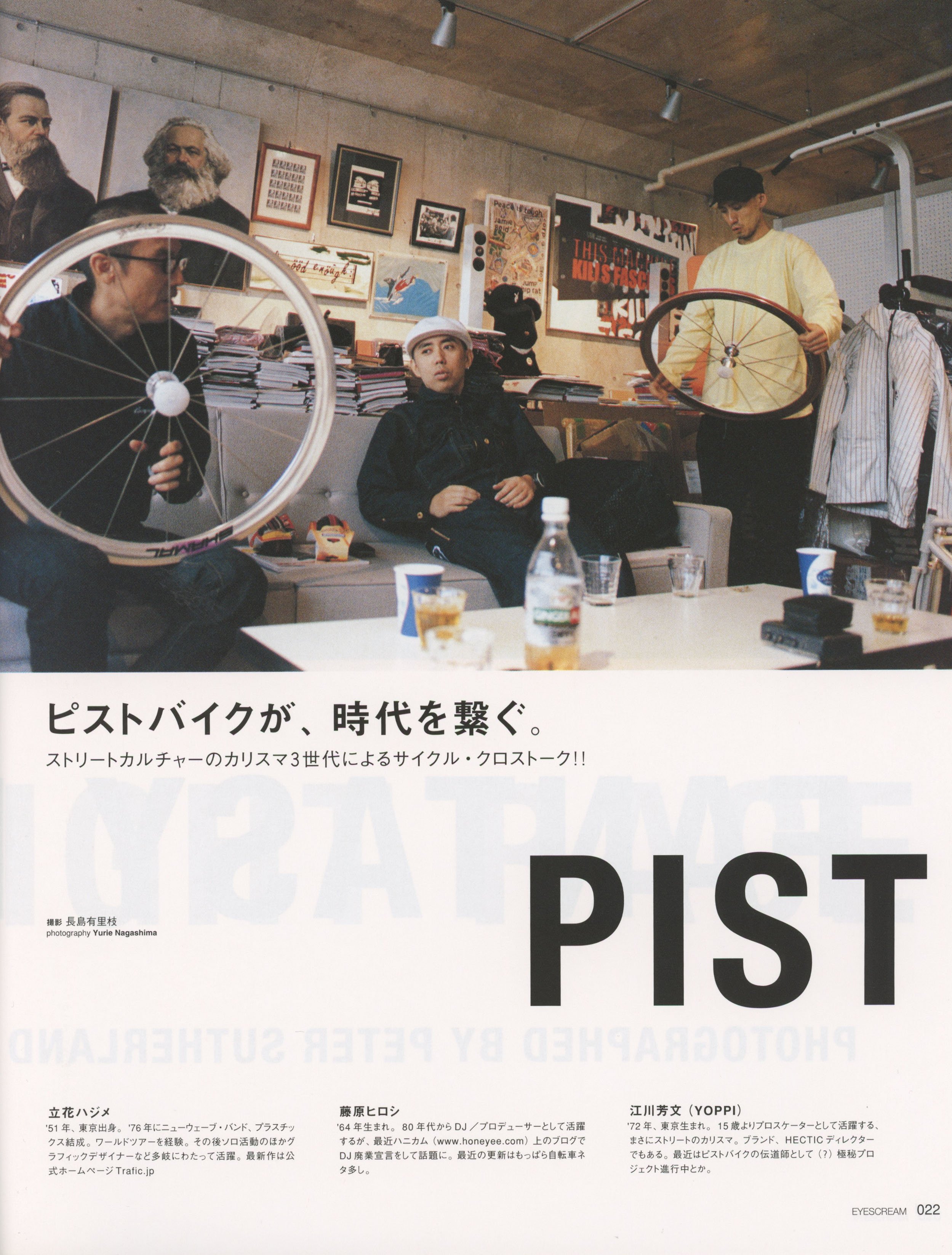
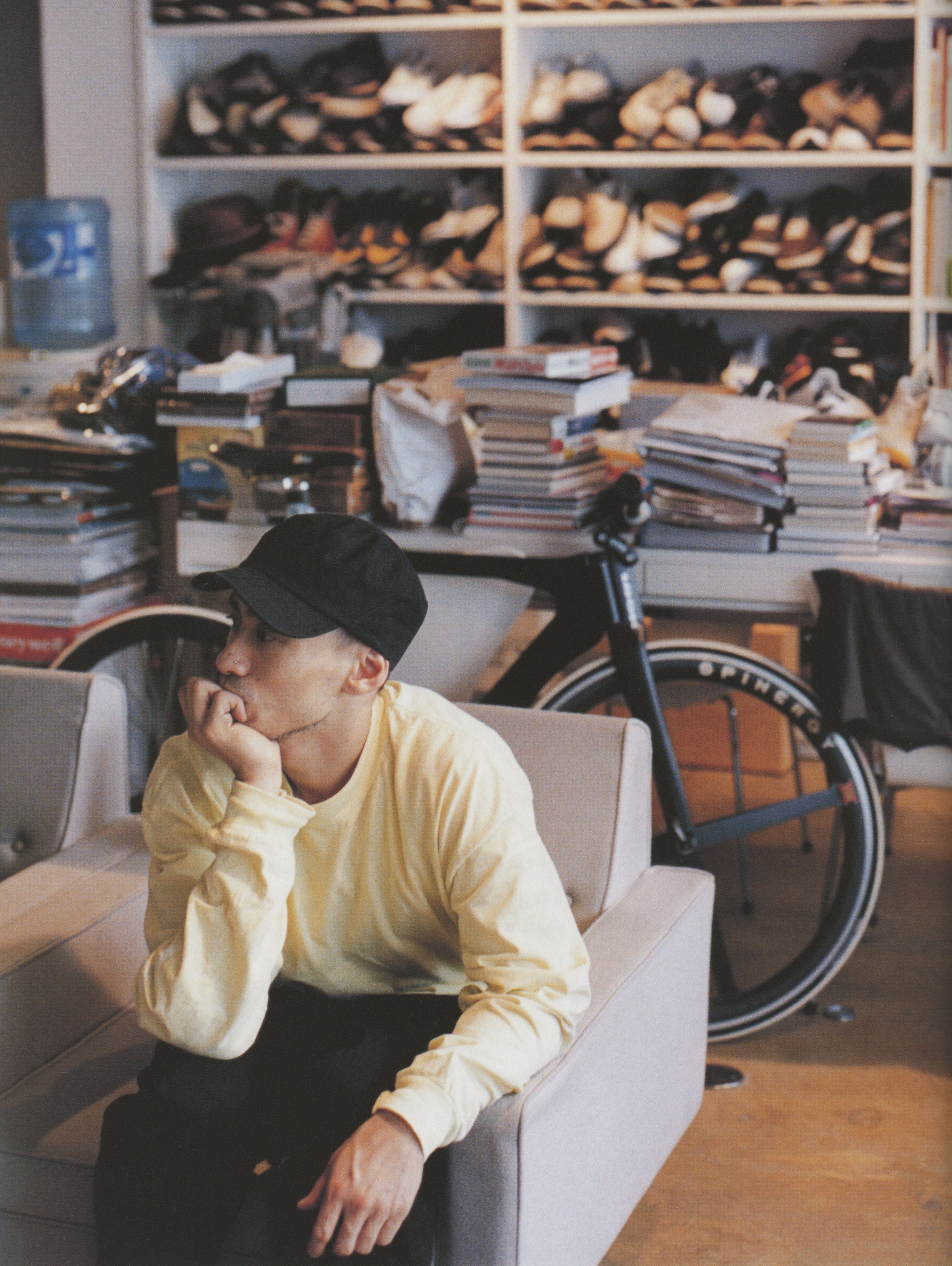
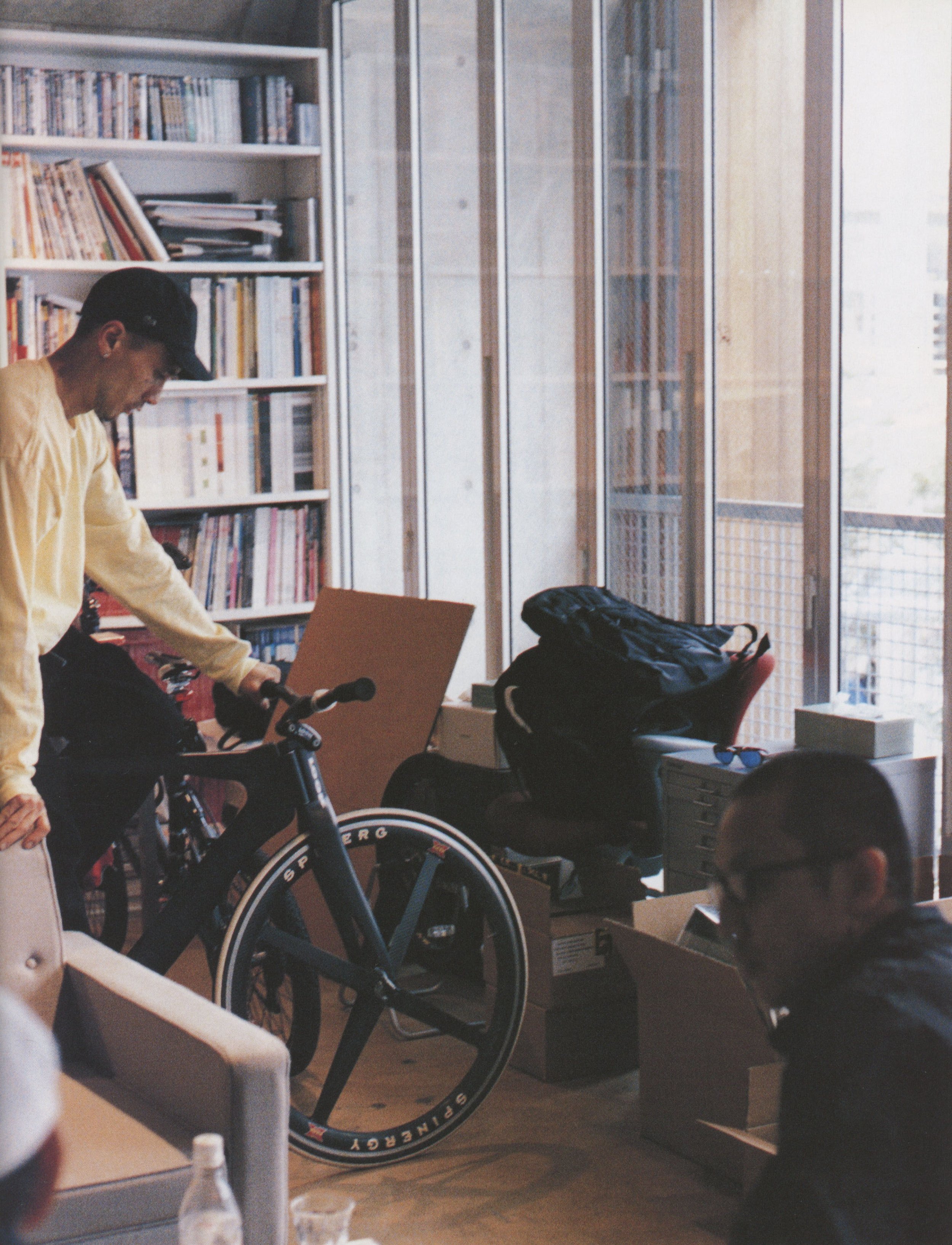
Did other people who were part of UraHara scene buy fixie bikes at CARNIVAL?
他の裏原に関わってた人たちもカーニバルでピストバイクなど購入していたんですか?
Because Hiroshi-san was very good to me, I personally brought him a special bike as a gift. This led to him becoming obsessed as well and coincidently, Hiroshi-san’s dad was a Keirin rider, so it all kind of clicked. Because fixed gear bikes are hard to ride, it didn't just end with me selling the bike and the customer buying it. I would share my knowledge and experience with them on how to ride the bikes and other know-how as well. I think this is the reason why people still come up to talk to me about CARNIVAL.
ヒロシさんには僕がお世話になったんでこの自転車かっこいいんで乗ってくださいって言って持って行ってました。でそれがきっかけでハマって、ヒロシさんのお父さんもたまたま競輪選手だったりしたんで。固定ギアに乗るのって結構大変じゃないですか。今の人たちでカーニバルの記憶で残ってるのはそこで自転車売って、買って終わりではなくて、乗り方から考え方から僕が経験したものを共有する感じで。今でもカーニバル、カーニバルって言われますけど。
Hiroshi credits YOPPI as being a leader of the fixed bike scene.
So it wasn't just an ordinary bike store.
ただの自転車屋さんではない感じですね。
Yeah, but this was probably the two years where we were looked down the most by people in the road bike community. Maybe not even 2 years? But more and more people got into fixed gear, and there was a lot going on surrounding it.
そうですね、多分一番ロード自転車やってた人たちに嫌な目で見られた2年間ですね。まあ2年もやってないのかな?当時ピストバイクのことも結構知られて社会的にも色々あって。
During the time you ran CARNIVAL, did you have a fixie bike crew kind of like a skate crew?
カーニバルをやってた時期はスケートチームみたいにピストバイクチームみたいなのはあったんですか?
We did it with the same T19 crew. It became word of mouth within the scene how the skate crew T19 became a fixie bike crew. But this led to people carrying their skateboards while riding fixie bikes today, so I’m happy that this part translated to today’s people. Back then people thought I was going to die because we had no brakes. People still didn't understand what fixed gear was.
いや同じT–19でやってましたね。なんかスケートチームのT19がピストバイクチームになったらしいよ、ってなってやっぱりザワザワしてたんですよ。でもその今スケートボード背負ってピストバイク乗るっていうことのベースになったんじゃないですか?それはよかったな、通じたなって思うんですけど。当時はブレーキつけてないでYOPPI死ぬんじゃないのみたいに言われて(笑)。みんなピストの固定ギアの意味をわかってないから。
We heard you made original frames too, but how did that wind up happening?
カーニバルでオリジナルフレームも作られていたと思うのですが、どのような経緯で作るようになったのですか?
I wanted to make things you could only get at CARNIVAL! There were no places on a retailer scale that were making their own frames, so I designed them kind of with the same mindset as designing a skateboard.
CARNIVALでしか買えない商品開発!ピストフレームを小売店ベースで開発して作っている事が無かったので、スケートボードを作る感覚でデザインしました。
Is there a particular CARNIVAL frame or bike that means a lot to you?
CARNIVALで思い出の深いフレームや自転車はありますか?
The very first time I went to Italy to buy bikes was very memorable, especially De Rosa! When I got to their main store, De Rosa himself was just there, and I asked if they had any Pist bikes, and he showed me their stock in the basement. He asked “This one?” and I was like “Yes!”. There were 5 total, but I didn’t want to be the guy who buys everything, so i only bought 3 [laughs]. It all happened in like 5-10 minutes.
初めてイタリアに買い付けに行った事です。印象的だったのはDE ROSA!本店の入り口にDE ROSA本人がいきなり居てピストフレームありますかって?聞いたら地下の倉庫に案内してくれました。「これがいいのか?」「はい!」みたいな。5本あったのですが、買い占めるのもどうかと思い3本購入しました(笑)。ものの5分-10分の出来事です。
Do you have a go-to bicycle right now?
今気に入ってる自転車はありますか?
I just built this one by BROOKLYN MACHINE WORKS. I had the frame with me for a while but this bike is so hard to put together so I had to go on Mercari, Amazon, and Cycle Paradise to find the parts.
これ今組んだばっかなんですけど、ブルックリンのですね。元々フレームだけ持ってて。この自転車組むのすごく大変なんですけどメルカリとかアマゾンとサイクルパラダイスとかいろんなところを使って組みました。
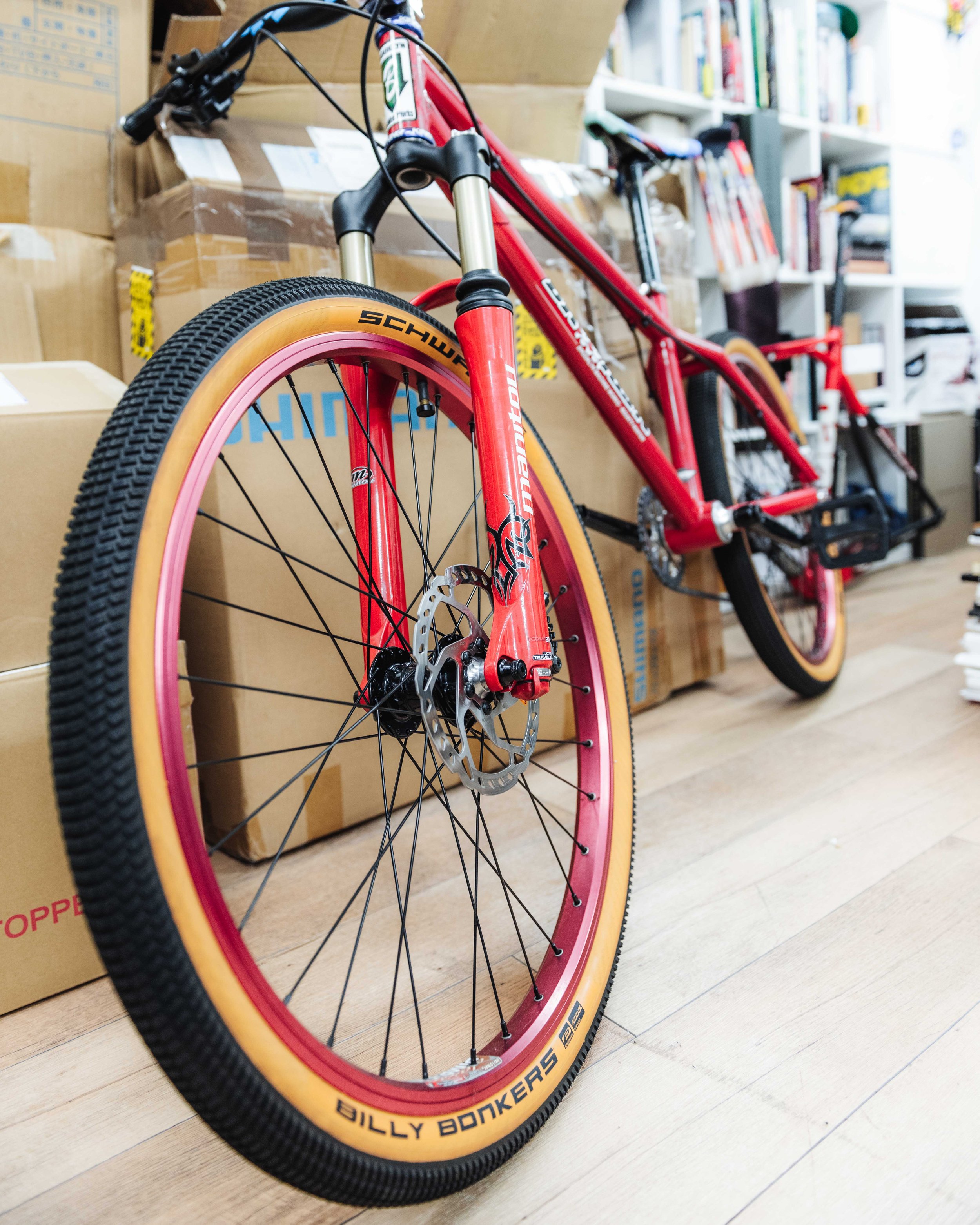
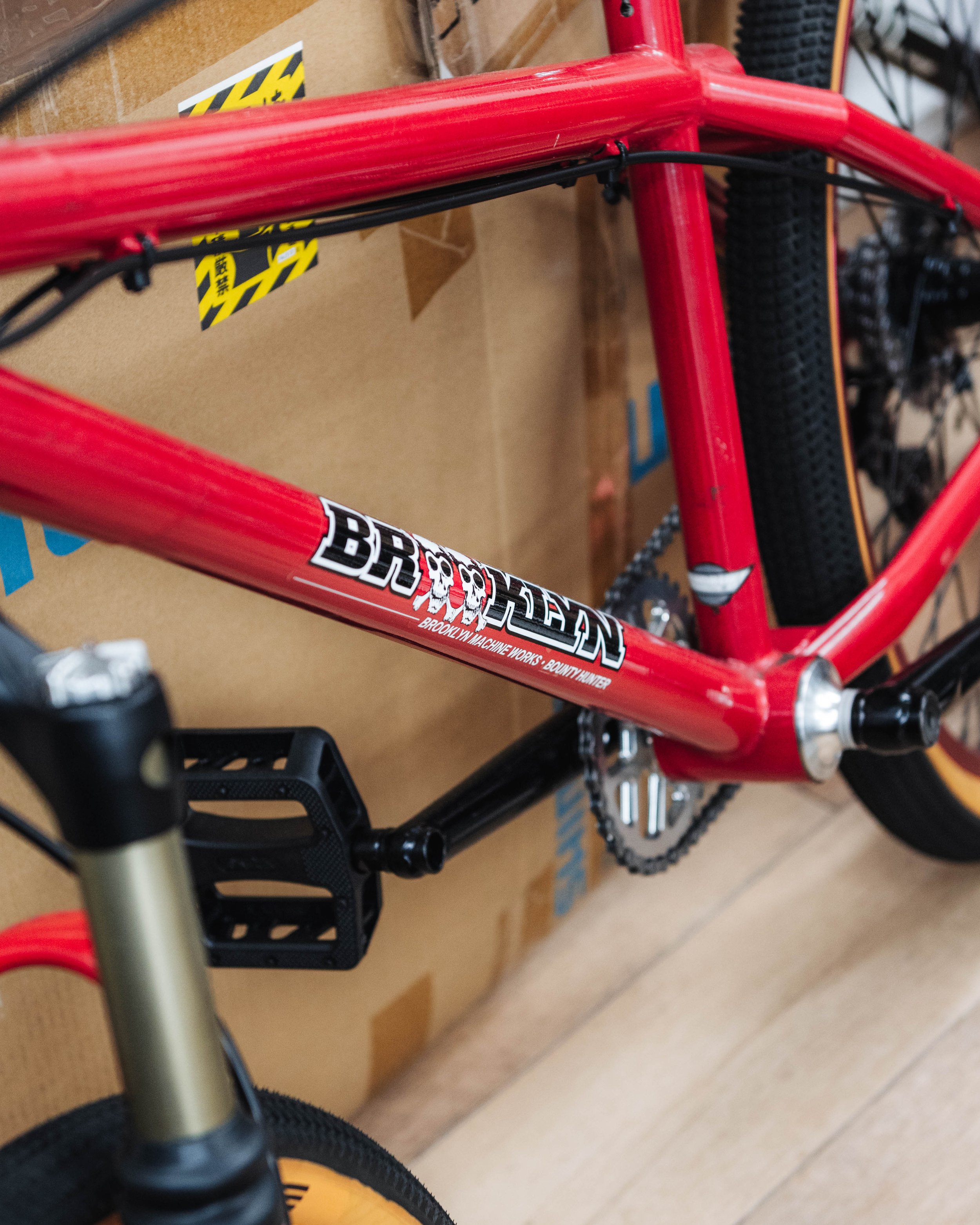
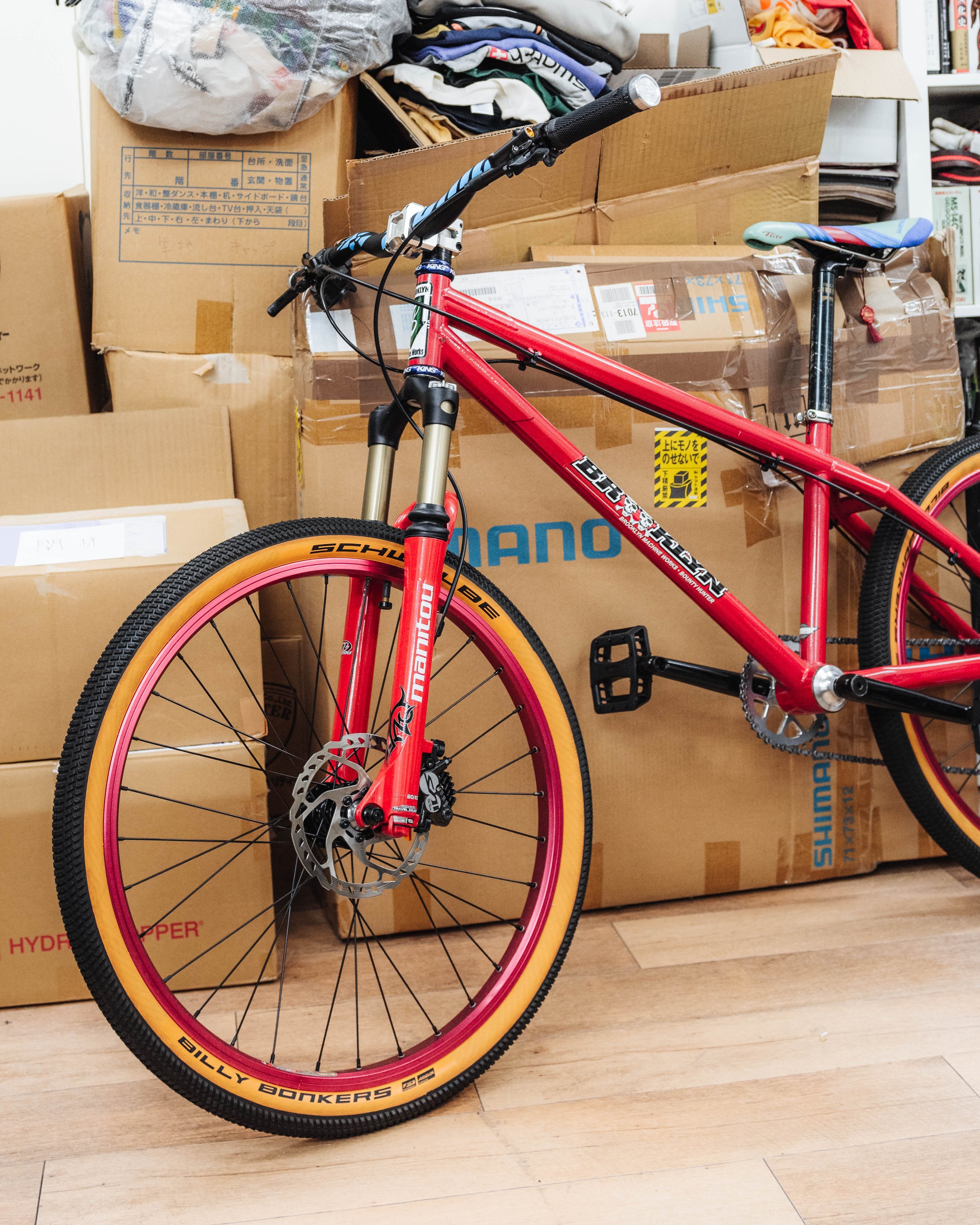
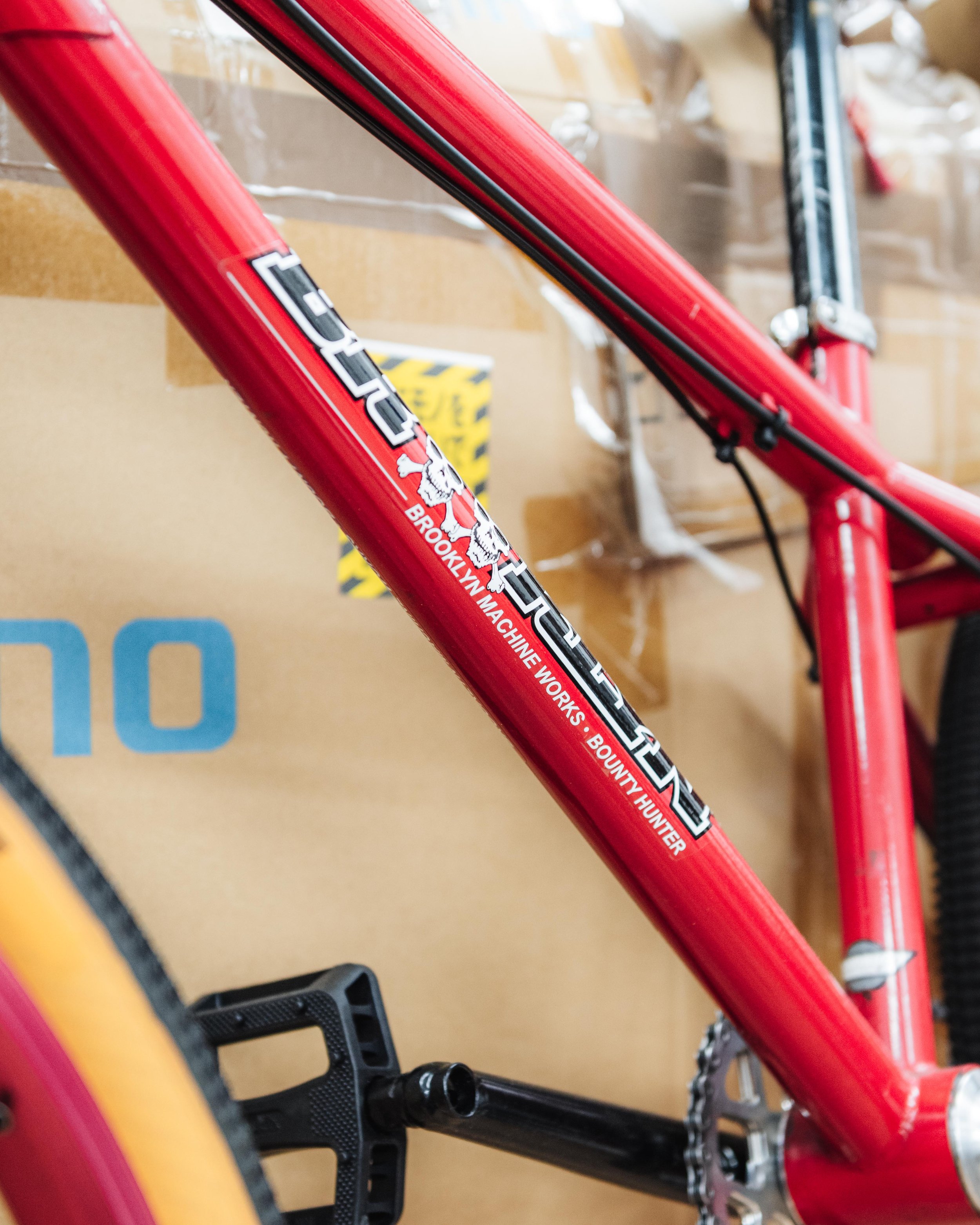
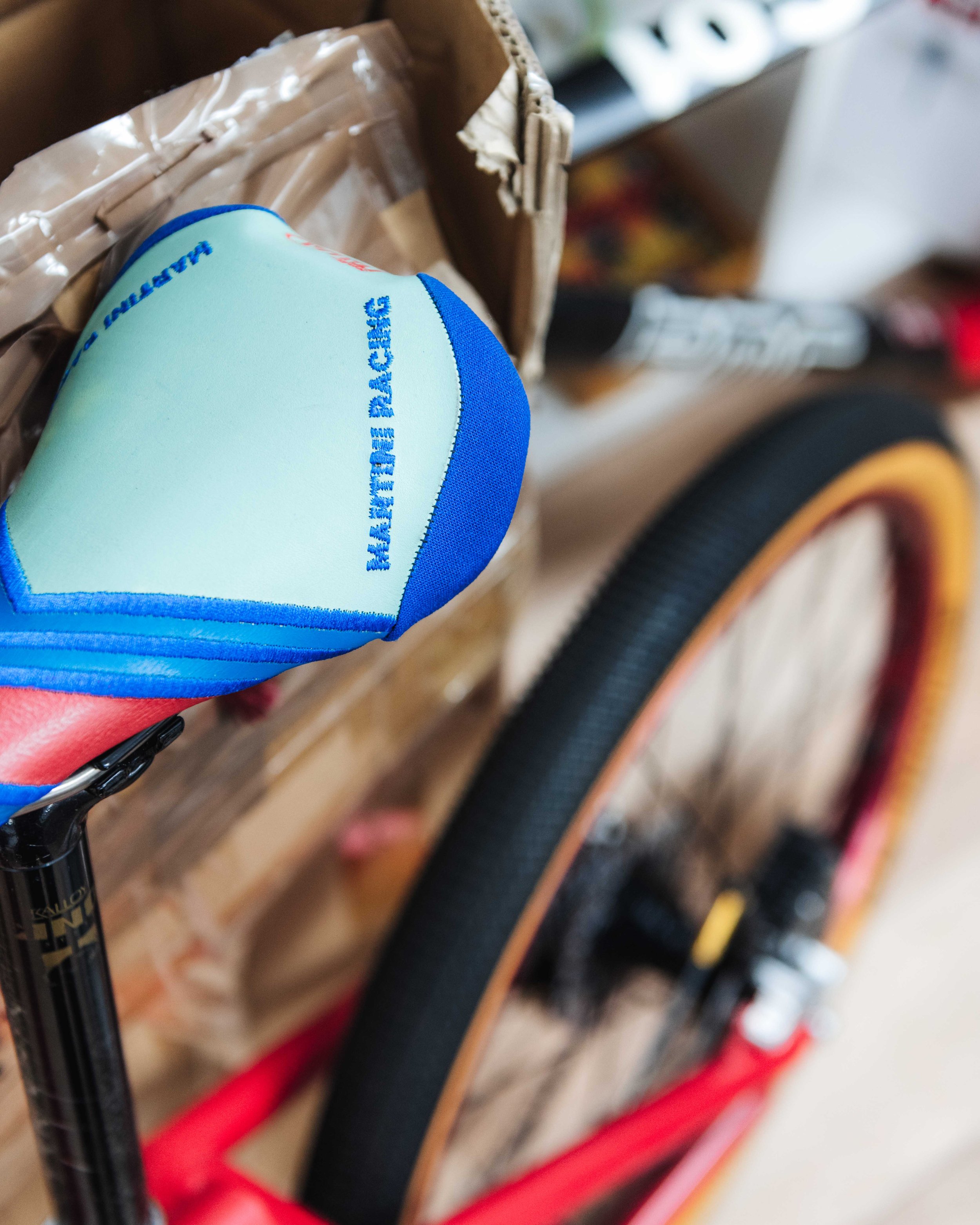
Have you ever done any bicycle related collaborations?
今までやってきたブランドの中で自転車関連のコラボとかってやったことありますか?
I did a collab with Hombre and W-BASE a couple times. It was more of a OEM type thing though. I still make bikes, like the Bathing Ape bike, I made that too.
オンブレでダブルベースと何回かやってます。割とちょっとOEMっぽい感じですけど。なんだかんだ今もずっと自転車作ってますよ。あのベイジングエイプの自転車とかも僕が作ったものなんですよ。
How did that come about?
どういった流れで実現したんですか?
Bape reached out to me to do a capsule collection and I was thinking about what do, and decided to make kind of a Bape Racing concept BMX bike.
エイプからなんか僕のカプセルコレクションやらない?って言われて。何やろうかってなってベイプレーシングみたいなコンセプトでBMXのレーシング自転車作って。
A BATHING APE DIRTRACE
Could you tell us a funny or memorable moment from CARNIVAL?
CARNIVALであった面白いエピソードや思い出深いエピソードをお聞きしてもいいですか?
I would have to say when police would wait on both streets next to CARNIVAL, and stop all of us who were riding fixies. At one point, they would literally throw nets at us like fish to stop & catch us [laughs].
ブレーキ取り締まりで店を中心に道の右側と左側に警察が検問してたことですね。いっときはネットで魚の様に釣られてました(笑)!
We heard you also worked at Supreme as well.
渋谷のシュプリームでも働いていたとお聞きしました。
After HECTIC disbanded due to selling our copyright, it kind of hit me that this wasn't mine anymore. Around that time my kid was born, so I figured I needed a job. I asked a friend from ONEGRAM if there were any jobs, half-jokingly. He was surprised but offered me a job at a new Supreme store that was opening in Shibuya.
あれはHECTICが解散して、解散というかコピーライト売って、あー自分のものじゃなかったんだってなって。ちょうど僕子供が生まれて、仕事がなくなったから仕事しなきゃってなってなったんですけど、ワングラムの友達になんか仕事ない?って半分冗談で半分本気で言ったら、えっ!なって、シュプリームの渋谷店が開くからそこで働かない?っていう話をいただいて。
What was it like for a person of your caliber to be working the store front of Supreme Shibuya?
YOPPIさんのような方がシュプリームの店頭に立つのはどんな感じでしたか?
When I got asked by a customer to bring a Wallabee in his size, I would put the laces through, and he recognized me and in shock said “Wait!? Why are you working here, I came to buy Wallabees because you were wearing them!” and I would just kind of acknowledge that. Since we all lost our jobs after HECTIC disbanded, I felt that I had to set an example by working because working in retail is tough right? Working in retail, it made me realize that HECTIC was special, it was a lot different from other companies. A lot of us made a lot of money too so once we lost our jobs, it really hit us hard mentally. We didn't really know what to do next and there was self-doubt if we could work at a normal company. I thought after working here, I would be able to move on to my next step. Originally I was going to quit in 3 months and just kind of help out for the store launch, but before I realized it I was there for 2 years.
お客さんに頼まれて裏からワラビーのサイズ持ってきて、紐とおしてたら、「えっ!なんで働いているんですか?!僕ヨッピーさんがワラビー履いていたから買いに来たんです」って言われて、そうなんですねって言って(笑)。僕はあの当時はHECTICが解散になってみんな仕事がなくなったんですよ。やっぱりお店の店員さんって大変じゃないですか?だからその僕がそういうので働いているのを見せることによってやっぱりHECTICで優遇されてたな、って感じました。他の会社とは一線があって、収入もあった子も色々いて、僕もそうなんですけど。でまあ一回バアーってなってやっぱりメンタルやられるんですよ、仕事なくなると。どうしていいかわかんないというか。普通の会社で働いて、次のステップにいけるんじゃないかなっていうのもありつつ。3ヶ月くらいで辞めるつもりだったんすよ。だから最初の立ち上げの時だけ手伝ってすぐやめる、みたいなノリだったんですけど、けど気づいたら2年いて。
Working in retail makes you appreciate street culture a lot more afterwards.
店頭に立つとその後もっとストリートを楽しめますよね。
I basically did the opposite of that. When I did HECTIC, I worked at the storefront a bit too but I was never punctual and would always arrive later than the store opening time. So after the disbandment and when I started working at Supreme, they would tell me that I can’t be late and if I was late twice I would be fired. So this was also a personal test on how well I could adjust socially outside of HECTIC. Although setting an example for other former members of HECTIC was important, this might have been the most valuable lesson from working in Supreme because there was self-doubt within myself if I could adjust properly. So this motivated me to work hard and I ended up being late zero times, and didn't skip any shifts as well. But in exchange, I didn’t go out for about 2 years at night because I was too tired after work. It was still a good experience though.
僕はその逆をやっちゃったんですよ。もうそのHECTICってやつをやって、店員もやってたんですけど、全然時間がルーズでHECTICのオープン時間にも遅刻ばっかしてて行けなかったんですよ(笑)。解散になってからシュプリームで働くことになって、遅刻はできないよって言われたんですよ。2回あったらクビだからねって言われて自分なりの社会性のテストでもあったんですよ。そっちの方が大きいかな。HECTICの周りのスタッフがどうのこうのってのもありますけど。自分これからちゃんとやっていけるのかなって言うのもあって、頑張ったんですよね。だから無遅刻、無欠勤でやり通せました。そこはすごい成長して、そのかわり2年間夜遊びもほぼしていない。もう疲れちゃって。いい経験でしたね。
Till this day, Japan has a large number of Supreme stores compared to the rest of the world, why do you think this is the case?
日本は今でも圧倒的にシュプリームの店舗数が多いと思います。理由などはあるのですか?
ONEGRAM and HECTIC would go buying together and the CEO of ONEGRAM at the time understood the potential of Supreme in its earliest stages. Back then, there was only the one store in New York and because of the fact that it was a skate shop, the recognition as a clothing brand was bigger in Japan compared to the U.S. So he looked into that and made more stores in Japan. In the beginning, we stocked Supreme at HECTIC as well, but when the first Daikanyama store was about to open it gradually faded away from HECTIC. The number of stores increased, and the few years before the Osaka store opened, Kate Moss was used for the photo tee series and this lit the fire on the brands popularity and led to the 100 percent sell rate. That was the start of a new era.
ワングラムとHECTICって元々一緒に買い付け行ってたんですよ。ワングラムの当時の社長が一番早い段階でシュプリームの可能性をキャッチしてたんですよ。その当時はアメリカの1店舗しかなくて、ニューヨークに。スケートショップだし、でも洋服としての認知度はアメリカより日本の方が高くて。そこに着目して日本に店舗数を増やしたんですよ。で最初HECTICでシュプリームを扱ってたんですけど、そのHECTICからシュプリームを抜いて代官山に一号店をだすっていう段々フェードインフェードアウトしてって、そんな感じで増やしてましたね。すごいゆっくり階段上がってく感じでその大阪店開けるまで何年かあってその間に本国でケイトモスを人物Tシリーズに採用したことなどもあって火が付いて。認知されて、こう時代が始まって行くんじゃないんですかね。
What was the next step after working at Supreme for you?
シュプリームでの時間を終えて、次のステップは何でしたか?
Since I always liked Supreme, I fit into the store smoothly. Also I thought that it was a good idea to make connections at the store for the next step in my career. I guess that's the case for everybody, kind of a gateway I guess. I mean things are a bit complicated in my case because the process was reversed but because James Jebbia was a genius and ran the brand properly so I was able to study from that. I was able to learn that just having momentum doesn't lead to success and after learning all this I started thinking about my next step. I didn't want to quit designing clothing so I would work on Hombre while working at Supreme. I felt that if I quit designing even once, I won’t be able to get back into it and thought this was my strength as well. But since I worked at the store from morning till night and because I was the oldest, I would work the hardest so I didn't have the energy to work on Hombre after work, but I still felt that I needed to push through so I would work on Hombre as well. After experiencing these 2 years nothing really scared me anymore because I couldn't be late and had a child to take care of. I just felt I had something I needed to overcome, needed to accomplish.
シュプリームが好きだったからすんなり店舗には入り込めて。シュプリームで働くのは全然嫌とかではなかたtんですよ。そこで次のステップのためのコネクションを作るのにもいいのかなってタイミングだった2年って感じでした。まあみんななんかそういう感じですよね、登龍門というか、結果僕の場合複雑なんですけど。逆だからなんて説明すればいいかわかんないんですけど、ジェームスジェビアがやっぱり天才的で。なんていうかちゃんとしてるというか。そこの勉強も再度できたし、勢いだけじゃだめだというのもわかったし。それも踏まえて自分の立ち位置で今後どうしようか、みたいな感じでした。やっぱり服のデザインをするのはやめたくなかったので、シュプリームで働きながらオンブレやってたんですよ。そこはやっぱり自分の武器というか、デザイン一回やめちゃうと戻れないというのがどっかにあって。けどお店で朝から晩までやって一番年上だったんで仕事するわけじゃないですか。その後にオンブレのデザインなんて全然できなくて、でもその中でも頑張ろうっていうのがあってやってたんですよね。だから今はあまり何も怖くないというか。あの2年間は怖かったというか遅刻もできない、子供もいる、でもなんか俺超えなきゃ行けないものがあるな、みたいな感じでした。
In a way, was this the first time you felt somewhat under pressure?
ある種のプレッシャーみたいなものを感じたのもシュプリーム時代が初めてですか?
Yeah, I mean it was still very comfortable for me, I became more convincing as well. And in a way I was able to humble the part of me that was getting cocky so I guess they made me into a proper person. Looking back on it, I can say this but in the moment, I was just struggling to make it 1 day at a time.
そうですね。でも結局居心地よかったですけどね。説得力もあるし、ただ自分の浮いていた部分を浄化するじゃないですけど、ちゃんとした人間に作っていただけたのかなと思います。今考えると。その当時は全然わからないので1日1日クリアして行くのがもう大変でした。
Did you start working a lot on Hombre NiÑo more after Supreme?
オンブレニーニョが本格的に始動したのはシュプリームの後ですか?
I forgot to add this but for fashion research purposes, it was the perfect environment because around 1,000 people would come to Supreme every day and I would learn what type of fashion was popular. I wouldn't say I used the opportunity, but I was able to absorb what was going on in the scene for designing.
さっき言い忘れたけどファッションリサーチをするには一番いい環境だったんですよ、シュプリームのお店に来ると1日1000人くらい来て、ファッション何が好きでどういうのがあって。まあ姑息にというか利用するじゃないですけど、吸収しながらっていう意味ではデザイン的にもよかったですね。
For people that don't know about Hombre NiÑo, how would you explain the brand?
オンブレニーニョを知らない人に簡潔に説明するとしたらYOPPIさんはどう説明しますか?
I would say we make clothes that are mature but also with a childish twist, a mix of retro and new.
大人子供っぽいレトロアンドニューな洋服を作ってます。
What led to your passion for graphic design?
グラフィックデザインへの興味はどこからきたのですか?
I had a lot of friends that did graffiti and also FUTURA and other names led to my passion and also I just genuinely enjoyed it. I really liked new artists and didn't really care if it was in trend or not and because I was a skater, that “wow” factor was important for me. Also I would cherish the connections that I would make. So I would reach out to graphic artists to work with me but because I would be older than them, they would basically ask me to do whatever I wanted. So I would just work on placement and color blocking because Artists usually have a better idea of what to do and I knew that my adult/childish ideas wouldn't really make sense.
多分グラフィティとか書く友達が多かったのと、そうですね、FUTURAとか何人かがとにかく好きで。新しいアーティストとかが好きで、後流行ってる、流行ってないとか関係なしにスケーターを見てあっ!ってなるかどうかを重要視してて。あと、繋がりを大切にしてやってました。僕はそのグラフィックアーティストに頼むところからきて、多分向こうは僕が先輩だからあなたの好きにやってくださいって感じになります。僕が考えるのは基本配置と色です。やっぱりアーティストの人って考え方がちゃんとしてるんで、僕みたいに大人子供的な発想があっても何言ってるかわからなくなるっていうのもわかっていたんで。
Considering your background, do you look at Hombre NiÑo as a Harajuku brand?
YOPPIさんの背景も踏まえて、オンブレニーニョは原宿のブランドっていうスタンスなんですか?
I want to ask that myself, I think my name kind of floats on its own, so the issue going onward would be how to put the focus on the product & brand. I think it is not interpreted properly, after 20 years I don't think the youth of today have any thoughts on Hombre Nino. Despite this I try to convey the brand by holding exhibitions with younger brands in Tokyo but I'm 50 already so there's a limit to try to fit in with today’s youth. But eventually I would like my son or someone that understands me to design for Hombre Niño.
それは僕が聞きたいですね。なんか僕の名前が一人歩きしていてちゃんとものを見てもらえているのかっていうのがオンブレニーニョの今後の課題ですね。ちゃんと伝えてないっていうか、ずっと続けてはいるんだけど20年経って今の若い子がオンブレニーニョについてどう思っているかってなると多分どうとも思ってないというか。そこをどうにか自分たちで発信したり面白いと思ってもらおうために東京の若い子のブランドと展示会やったりとかしてるんですけど中々難しくて。僕ももう50歳なんで子供っぽく若作りして頑張ったとしても中々限度があると思うんですよね。でもオンブレニーニョはゆくゆく息子だったり、以心伝心できる子にデザインしてもらいたいな。
How old is your son?
今息子さんはおいくつですか?
He is 13 right now, so he is about the same age as Hombre Niño so that's something to think about. The name of the brand is because of my son so that's another reason why I want him to take on the brand. I mean how many years do I have left right? I’m 50 right now so I don't think there are any streetwear brands that are run by a 70 year-old so that's something I want to do.
13ですね、しかもオンブレニーニョを始めた年と同じタイミングで生まれたんで。だから感慨ぶかいですね、後オンブレニーニョの名前もそれがあってつけたんで。だから渡したいんですよね。僕も後何年だって話じゃないですか、50なんで70までやってるストリートブランドなんてないからそれはそれで続けて見たいし。
We know you still walk through Harajuku everyday but as a person that has been a part of the Urahara movement, does it still feel special to you?
今でも毎日原宿に通っていると思うのですが、裏原を牽引してきた側の人間として特別感などはありますか?
When I was younger there were definitely more chances, but now with social media it became easier to promote your brand so there is no need to be based in Harajuku. So in that sense, it doesn't hold the same power as it used to. Despite this, I recently got an office for the first time in 10 years. Before that, I would just have meetings at Starbucks and stuff. But it’s good to see what people are wearing and what the atmosphere in the city is like, so I prefer this more than looking at social media on a screen.
僕なんかが若い時はもっとチャンスがあったんだと思うんですけど、今はSNSが増えて事業発信しやすい環境だから原宿じゃなくても場所を選ばなくなったじゃないですか。だからそういう意味では原宿っていうパワーは昔ほどはないんじゃないかな。それでも僕10年ぶりに事務所を借りたんですよ。それまで事務所なくてスタバとかで打ち合わせやってたんですよ。やっぱりいろんな人のファッション見れるし、街歩けば流れもわかるし。どうしてもSNSの画面で見るよりもやっぱり自分はそういう方が好き。
We’re near the end of the interview but what is your relationship with the music scene?
インタビューの終盤になるんですけど、ヨッピーさんと音楽の関係性について教えてもらえますか?
I can’t live without it. I started DJing even before I started making clothes. I was talking to my senpai the other day and he reminded me about how I was a DJ before anything else, and I had a moment of self-realization that this is the reason why I continue to DJ till this day. DJing, clothes, bikes, and skateboarding, they all kind of connect.
絶対音楽ないとダメっていうか、洋服作るよりも一番DJが早かったんですよ。こないだ先輩にヨッピー一番最初にやってたのDJだよねって言われて、あーだから続けてるんだってなって。まあ一応DJ、洋服、自転車、スケボーでトライアングル的な感じになってはいますね。
When did you start DJing?
DJを始めたのはいつ頃ですか?
I started when I was 18. Do you know what MAJOR FORCE is? I DJ’d for the first time with Takagi Kan-san’s MAJOR FORCE anniversary party at GOLD. But I ended up putting Stevie Wonder’s “I wish” at 45 rpm instead of 33 rpm because I was so nervous. I thought I totally messed up, but people danced to it too, which was nice.
18ですね。メジャーフォースってわかります?高木完さんのところでメジャーフォースの何周年かのゴールドっていうパーティーで始めたんですよ。そのゴールドのアニバーサリーで初めてDJしたんですよ。なのにスティーヴィーワンダーの「I WISH」を33回転のはずなのに45回転でかけちゃって。初めてで緊張して。完全にやっちゃったと思ったんですけど、それでもみんな踊ってくれて。ビビりましたけど(笑)。
We always ask this question near the end of an interview, but what is your go-to izakaya or restaurant?
インタビューの終盤でいつもする質問が一つあるのですが、YOPPIさんの行きつけの居酒屋、ご飯屋さんはありますか?今でも当時でも。
So there is this place called J-COOK that is owned by a married couple. They mix French countryside cuisine with some American elements. It’s very nice, you will probably be surprised because there aren’t a lot of places like this.
J-COOKってところが夫婦でやってるんですけど、フランスの田舎の料理とアメリカのフュージョン的な。おしゃれな感じですね。そこいいですよ、こんなとこあったんだ、ってなります。中々ないですから。
Do you have any last words for the younger generation?
最後に若いニュージェネレーションに向けて一言お願いします。
Just as Scha Dara Parr says, let’s continue the party, for ever and ever and even beyond.
スチャダラが言うように、パーティを続けよう、これからもずっとずっとその先も。
Thank you so much for your time today!
本日はお時間ありがとうございました!
Interview by: Casey Omori & Adrian Bianco
Text: Casey Omori
Interview Images: Natsuki Ludwig
Magazine Scans From Sabukaru Archive
Videos: T19 YouTube







